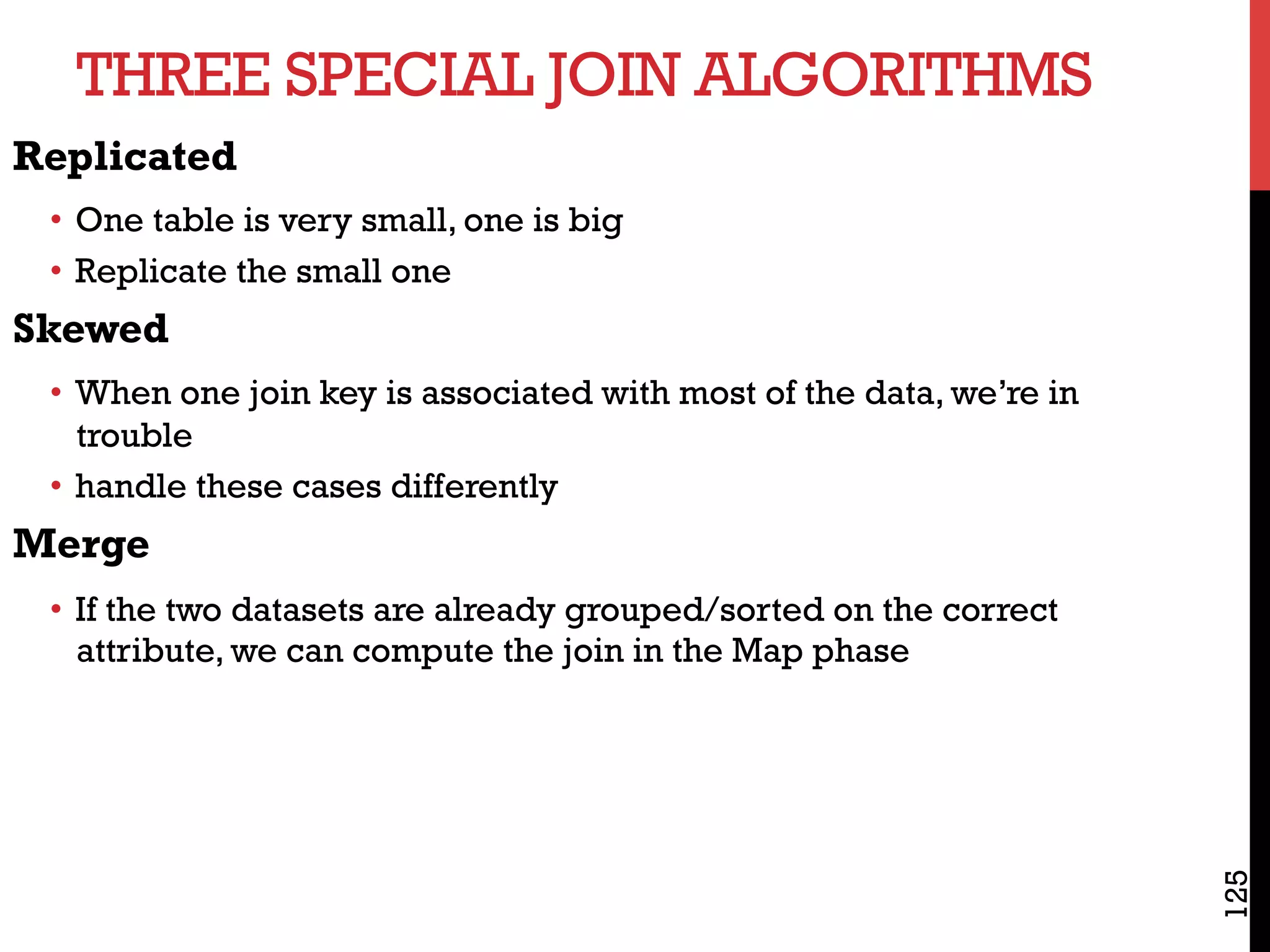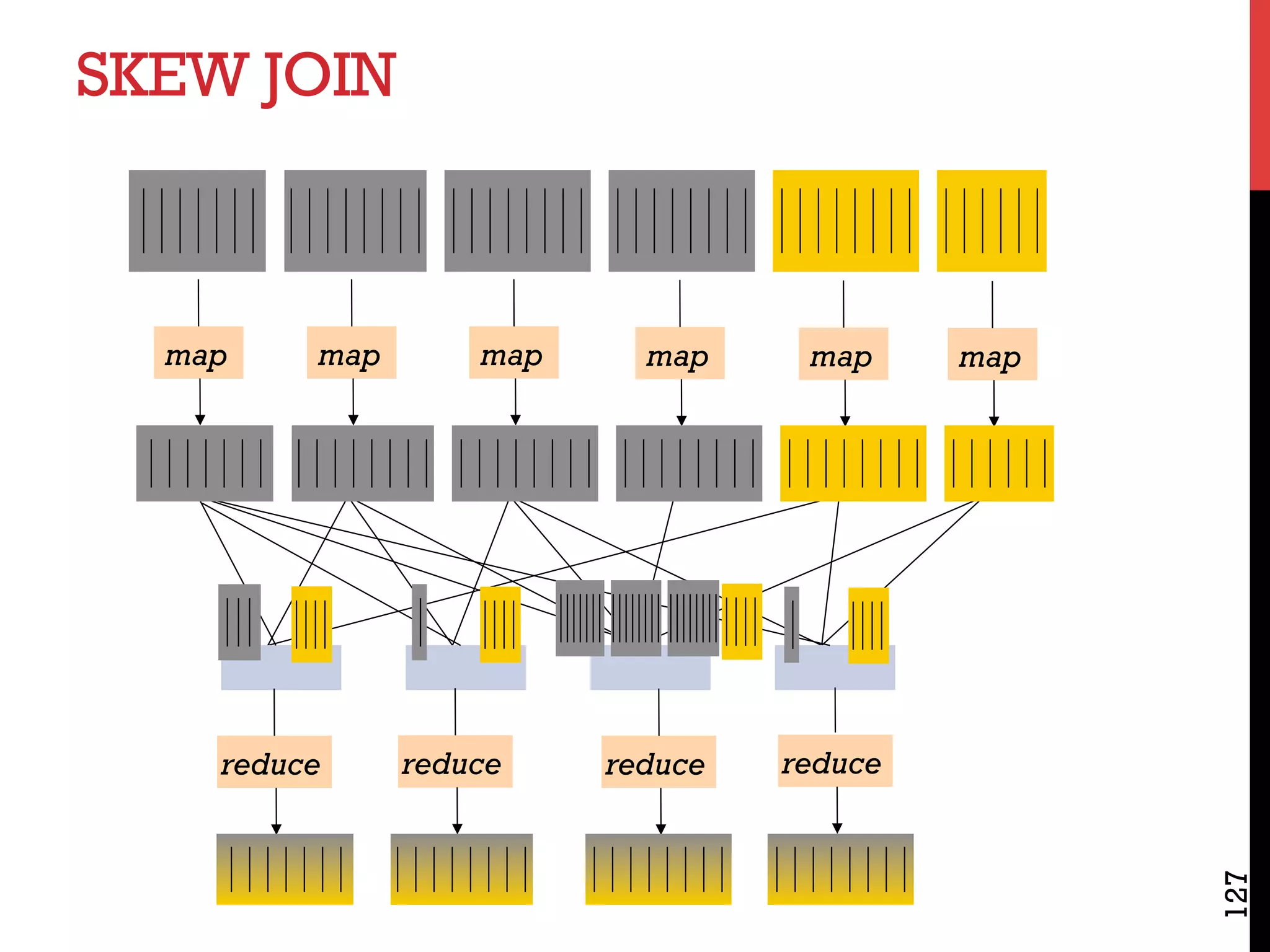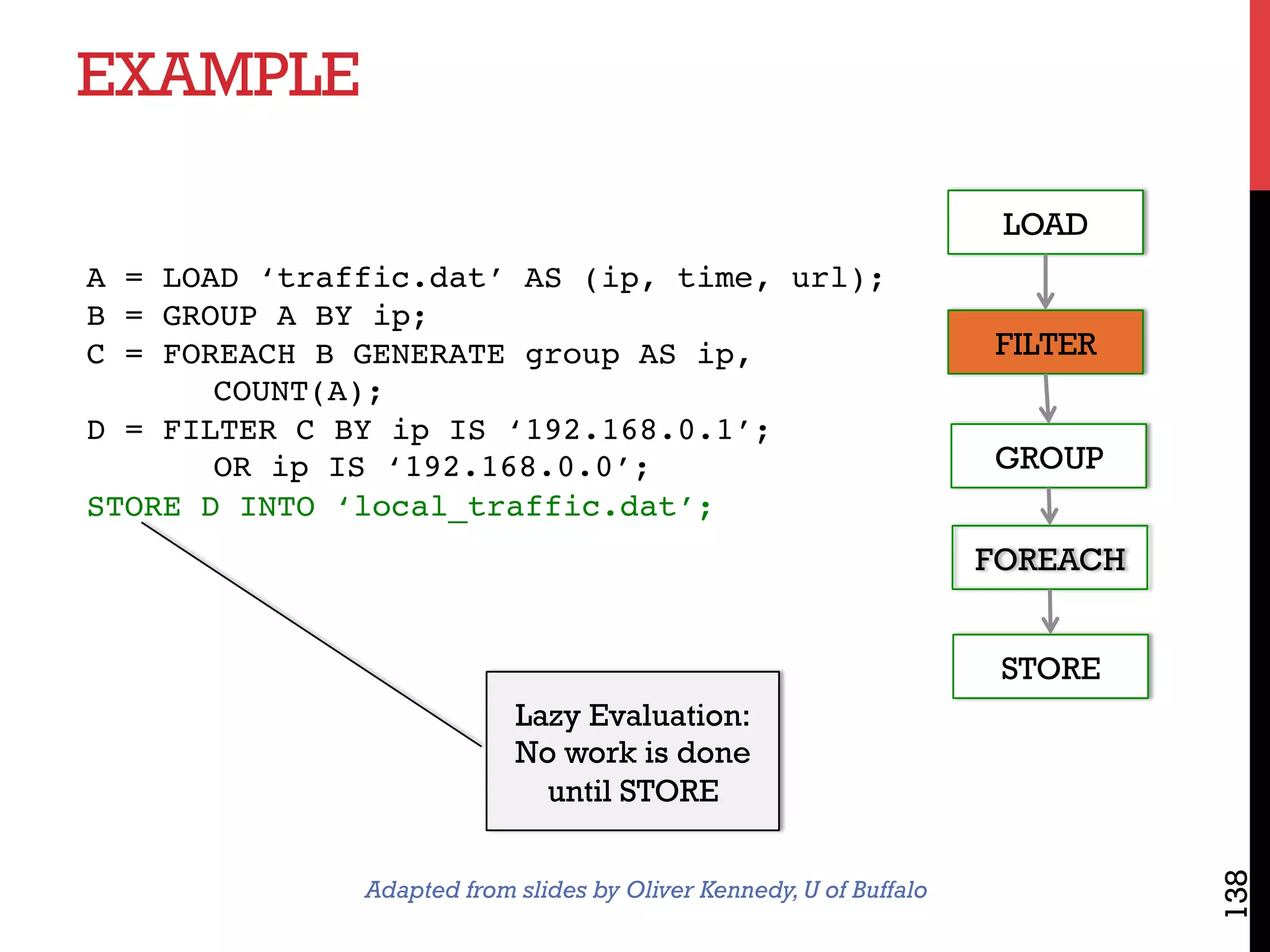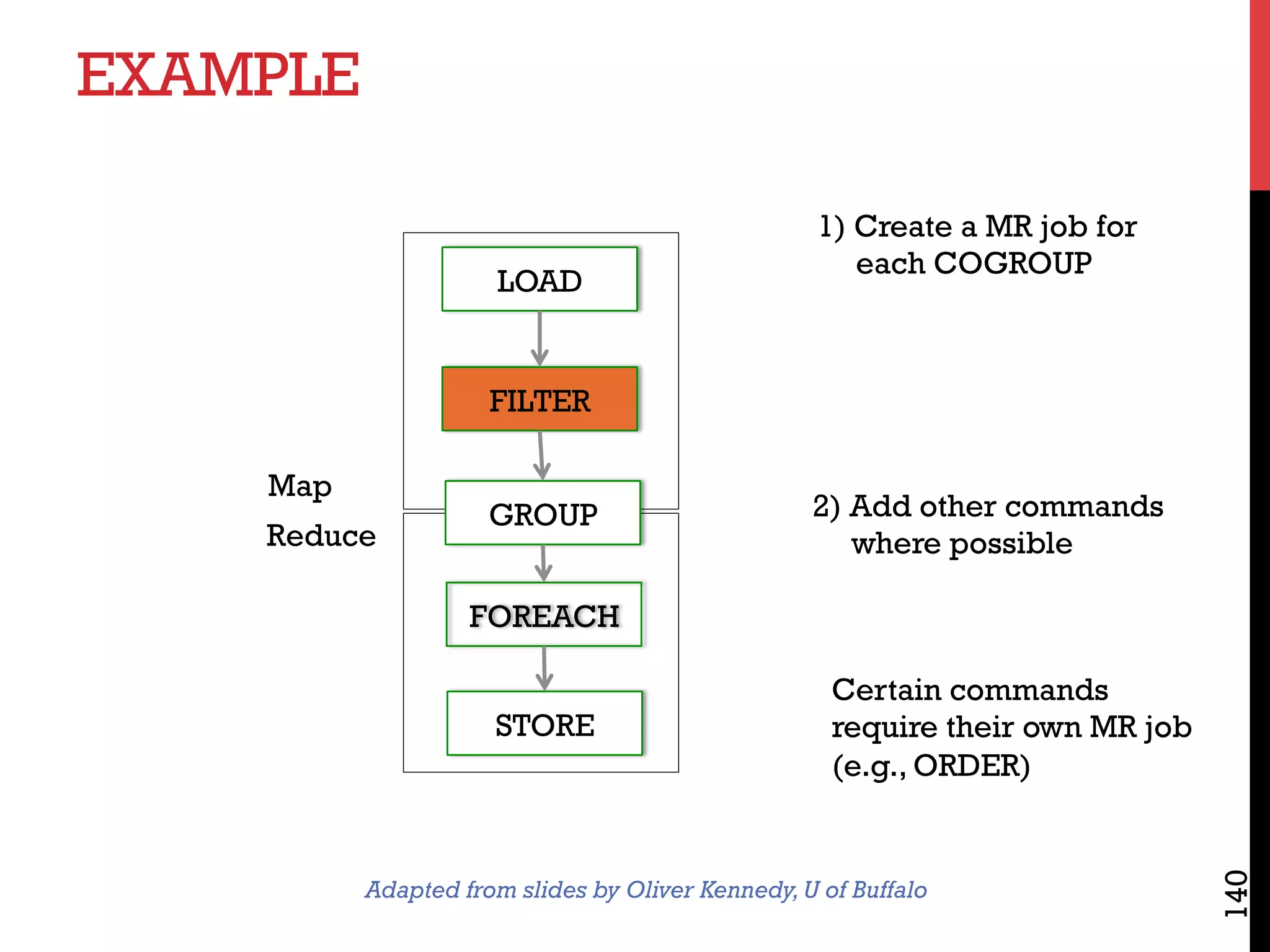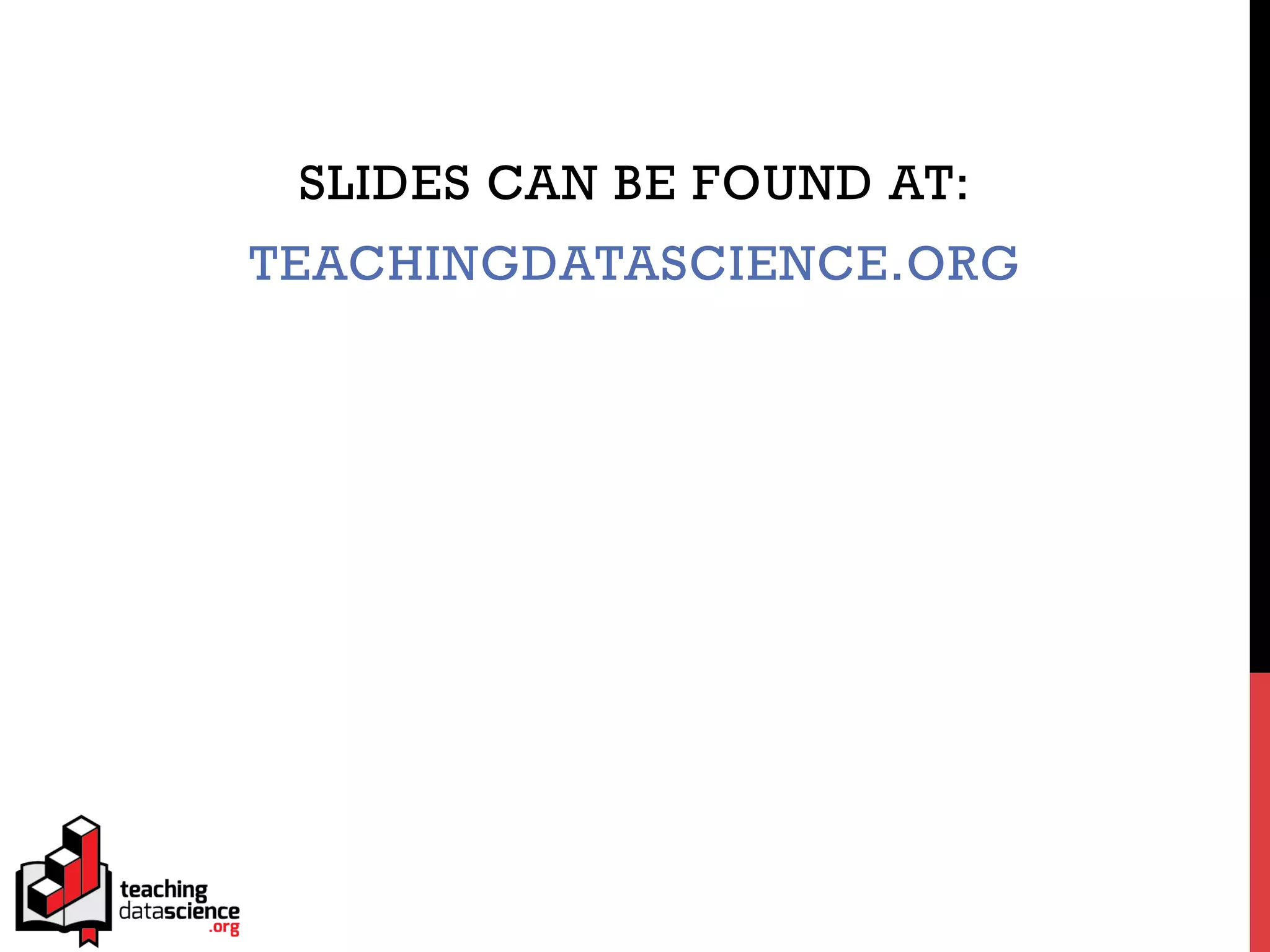The document discusses NoSQL databases and related systems. It provides a table comparing over 20 systems across features such as scale, indexing, transactions, joins/analytics, and data model. The key points are that scale is the primary motivation for NoSQL databases, which often sacrifice consistency in order to achieve high availability and partitioning across many servers. This relates to Brewer's CAP theorem, which states it is impossible to have all three of consistency, availability, and partitioning simultaneously in a distributed system.



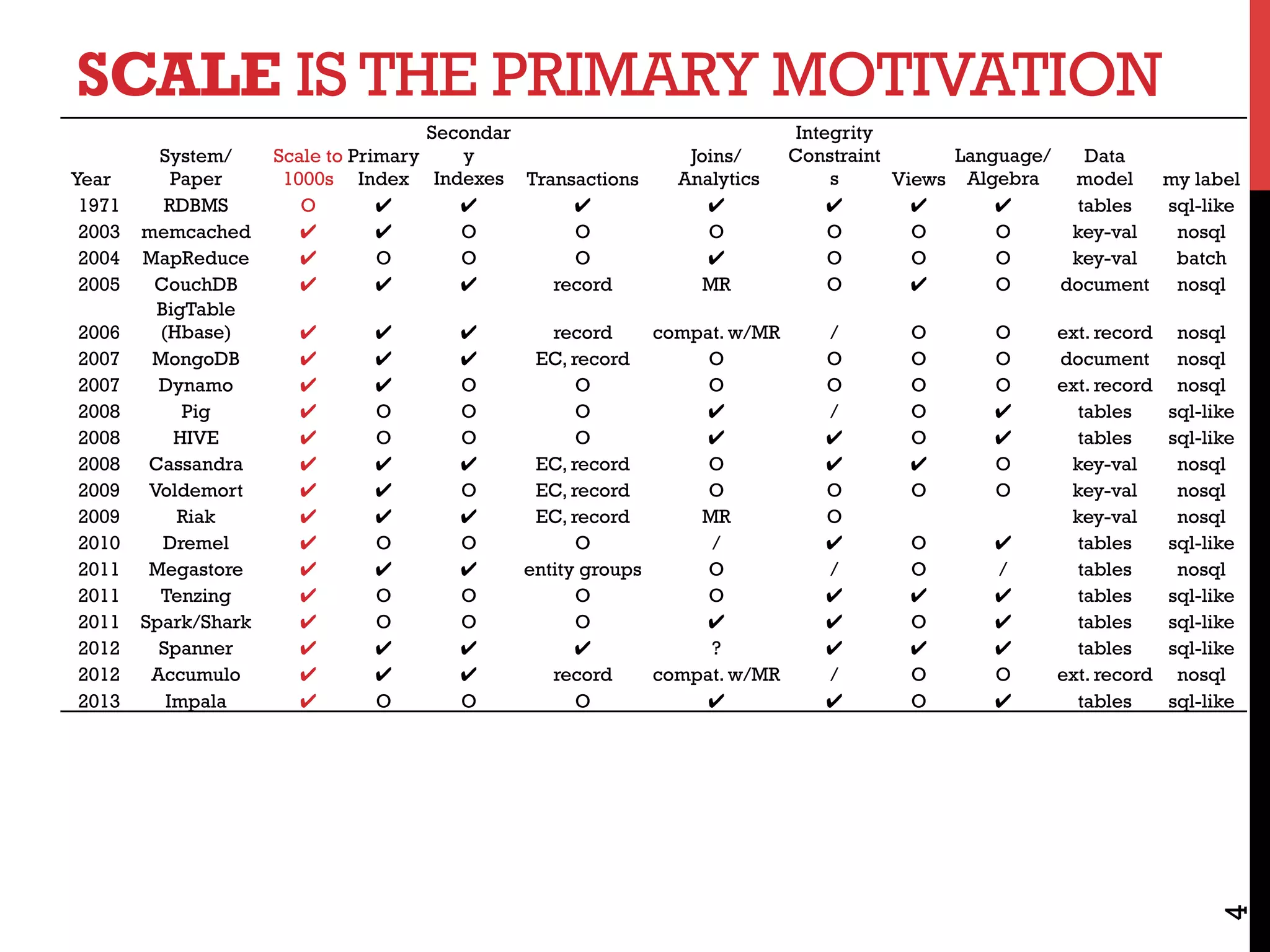
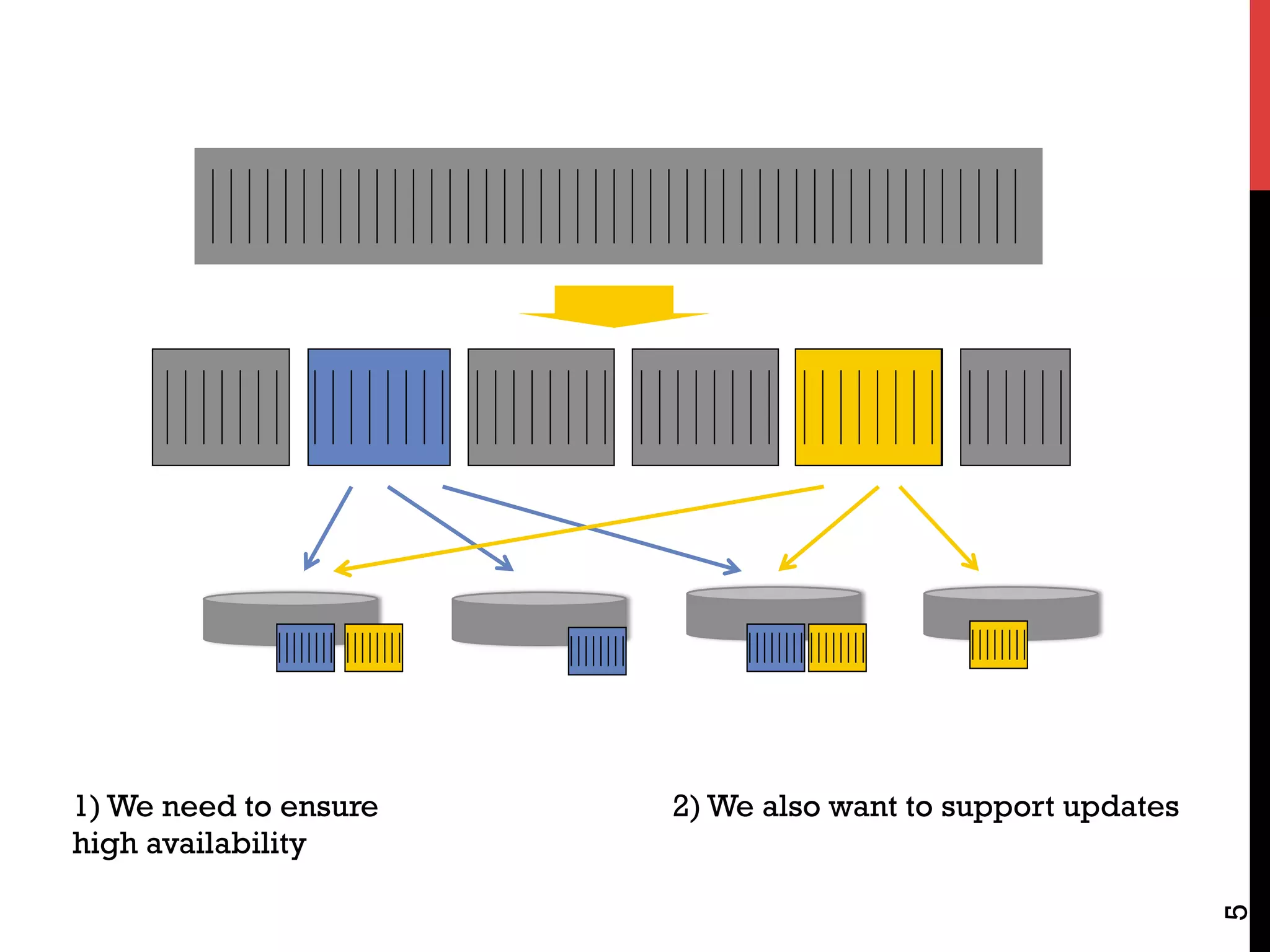






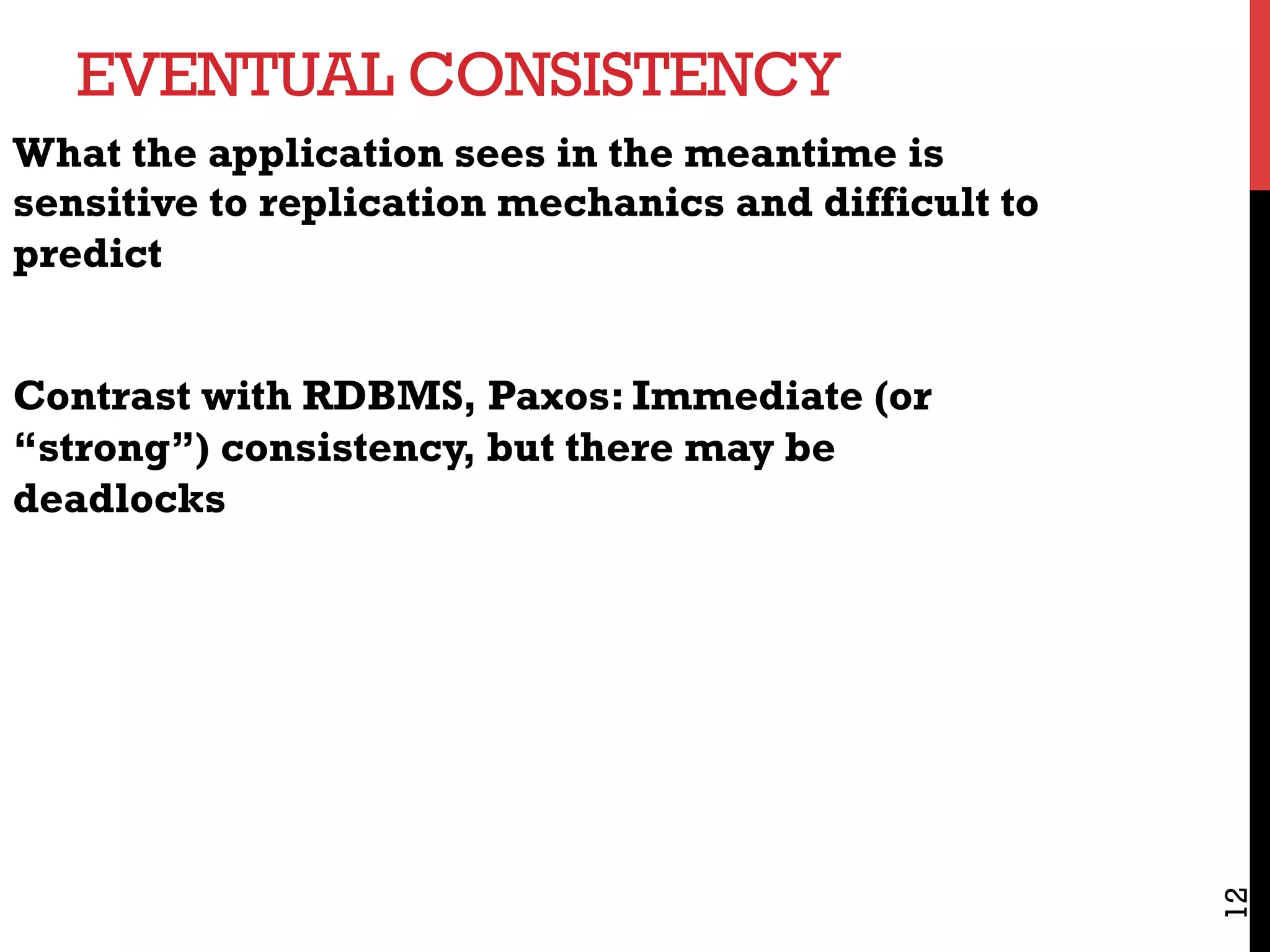

![CAP THEOREM [BREWER 2000,LYNCH 2002]
14
Consistency
• Do all applications see all the same data?
Availability
• If some nodes fail, does everything still work?
Partitioning
• If two sections of your system cannot talk to each other, can they make
forward progress on their own?
• If not, you sacrifice Availability
• If so, you might have to sacrific Consistency – can’t have everything
Conventional databases assume no partitioning –
clusters were assumed to be small and local
NoSQL systems may sacrifice consistency](https://image.slidesharecdn.com/billhowe4bigdatasystems-180131084727/75/Bill-howe-4_bigdatasystems-14-2048.jpg)





![MAJOR IMPACT SYSTEMS (RICK CATTEL)
• “Memcached demonstrated that in-memory indexes
can be highly scalable, distributing and replicating
objects over multiple nodes.”
• “Dynamo pioneered the idea of [using] eventual
consistency as a way to achieve higher availability and
scalability: data fetched are not guaranteed to be up-
to-date, but updates are guaranteed to be propagated
to all nodes eventually.”
• “BigTable demonstrated that persistent record storage
could be scaled to thousands of nodes, a feat that most
of the other systems aspire to.”
20
Rick Cattel 2010](https://image.slidesharecdn.com/billhowe4bigdatasystems-180131084727/75/Bill-howe-4_bigdatasystems-20-2048.jpg)







![MAJOR IMPACT SYSTEMS (RICK CATTEL)
• Memcached demonstrated that in-memory indexes
can be highly scalable, distributing and replicating
objects over multiple nodes.
• Dynamo pioneered the idea of [using] eventual
consistency as a way to achieve higher availability
and scalability: data fetched are not guaranteed to be
up-to-date, but updates are guaranteed to be
propagated to all nodes eventually.
• BigTable demonstrated that persistent record
storage could be scaled to thousands of nodes, a
feat that most of the other systems aspire to.
28](https://image.slidesharecdn.com/billhowe4bigdatasystems-180131084727/75/Bill-howe-4_bigdatasystems-28-2048.jpg)
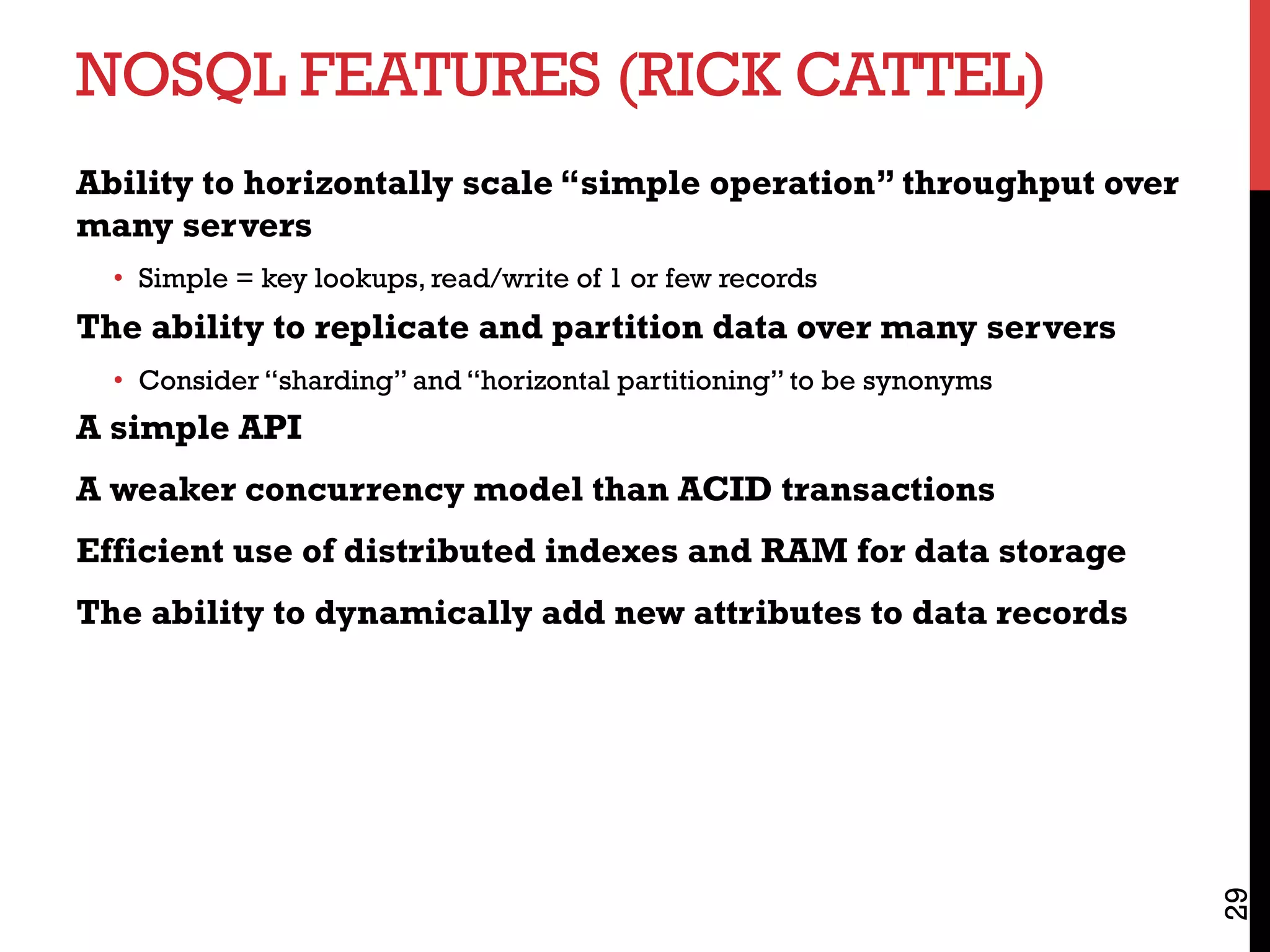


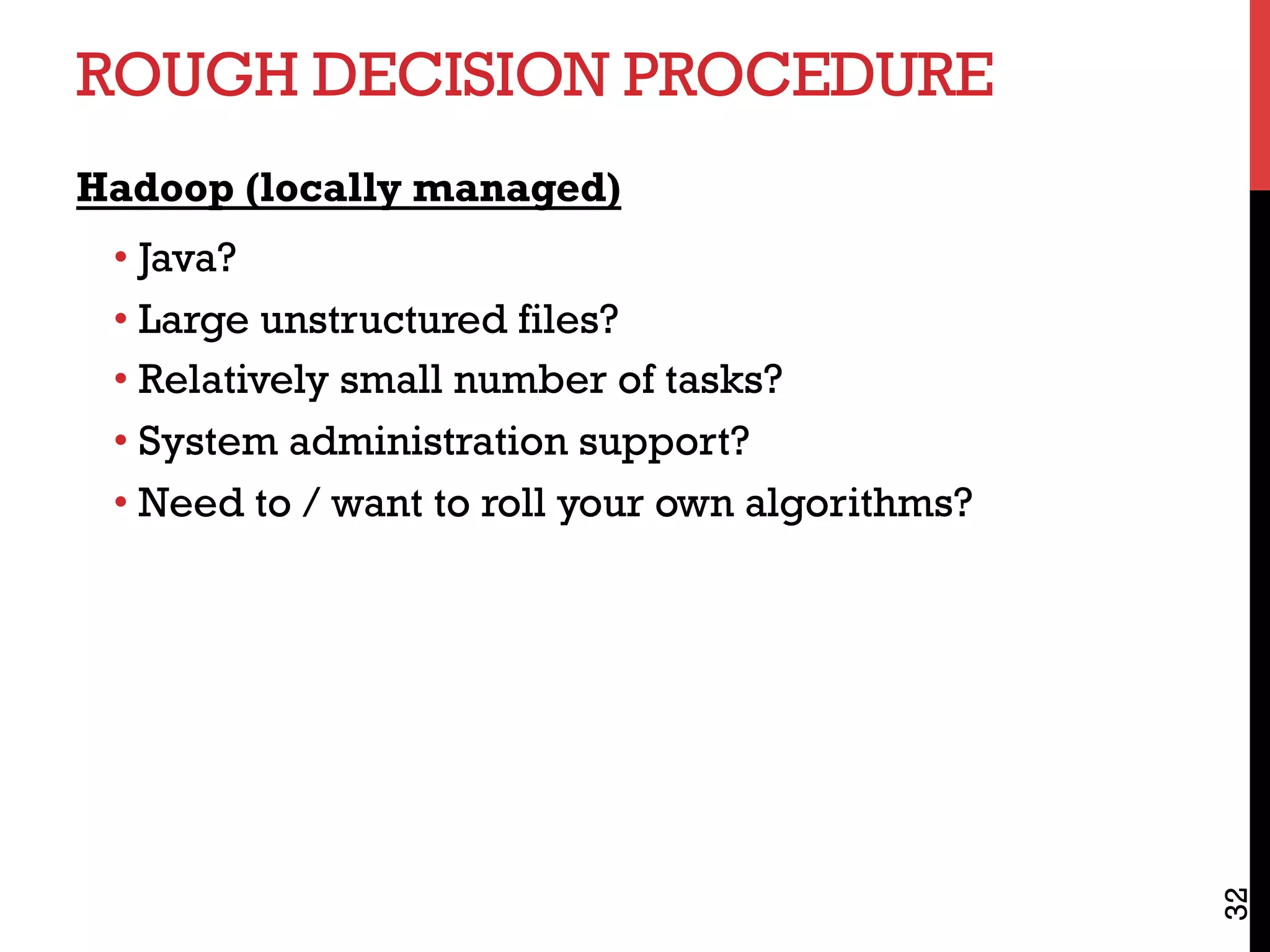
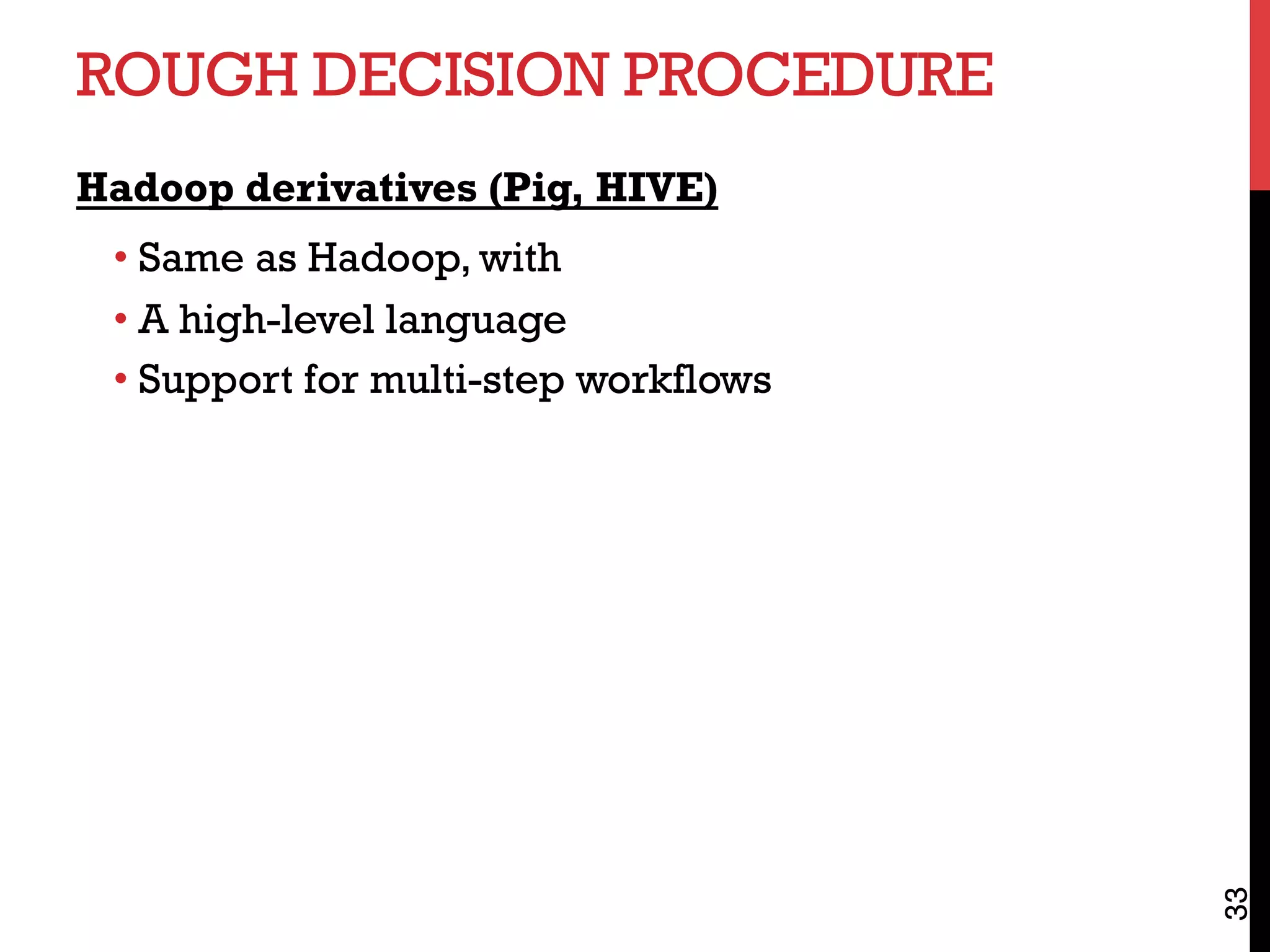




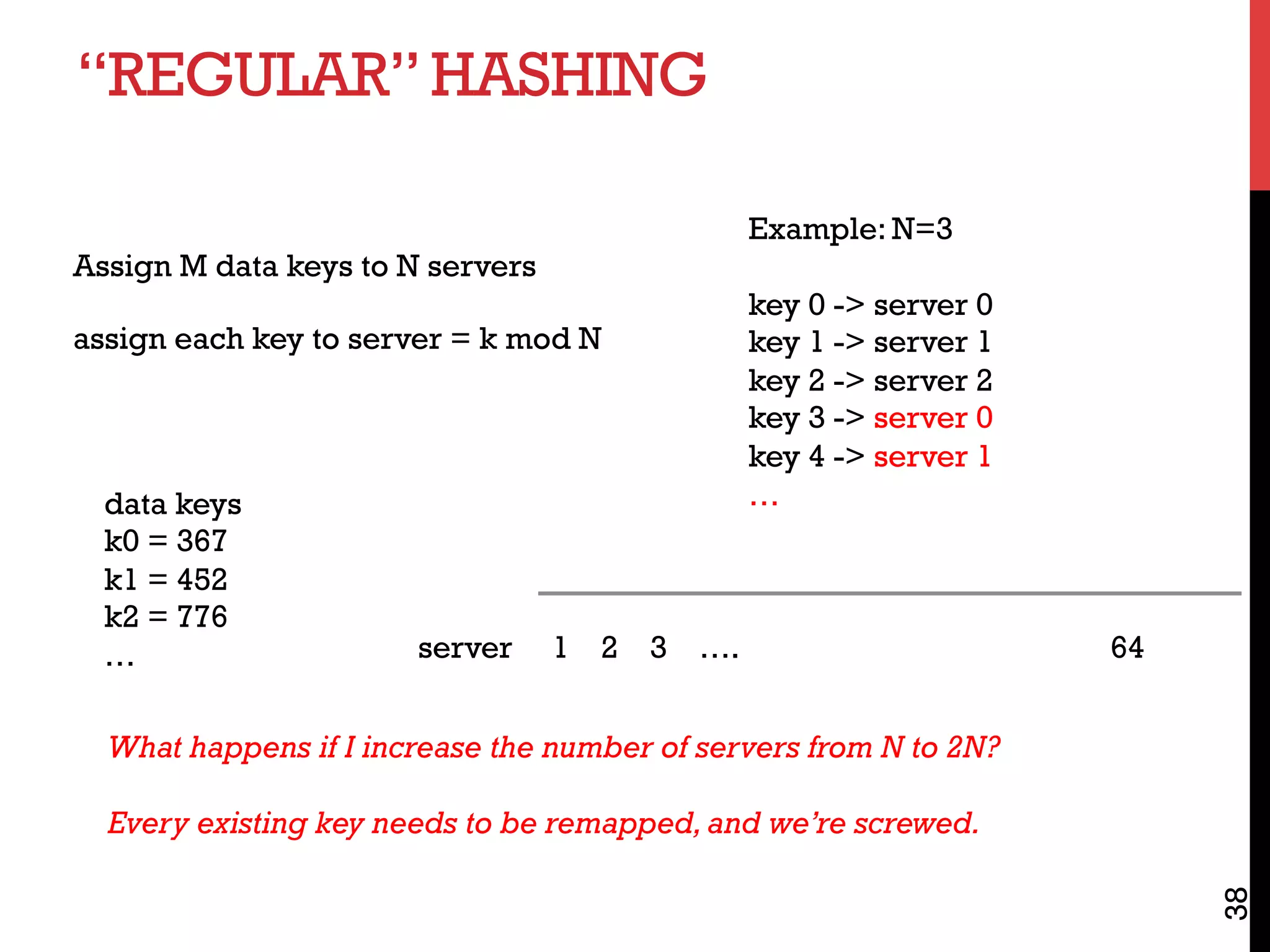

![COUCHDB:DATA MODEL
Document-oriented
• Document = set of key/value pairs
• Ex:
40
{
"Subject": "I like Plankton"
"Author": "Rusty"
"PostedDate": "5/23/2006"
"Tags": ["plankton", "baseball",
"decisions"]
"Body": "I decided today that I don't like
baseball. I like plankton."
}](https://image.slidesharecdn.com/billhowe4bigdatasystems-180131084727/75/Bill-howe-4_bigdatasystems-40-2048.jpg)



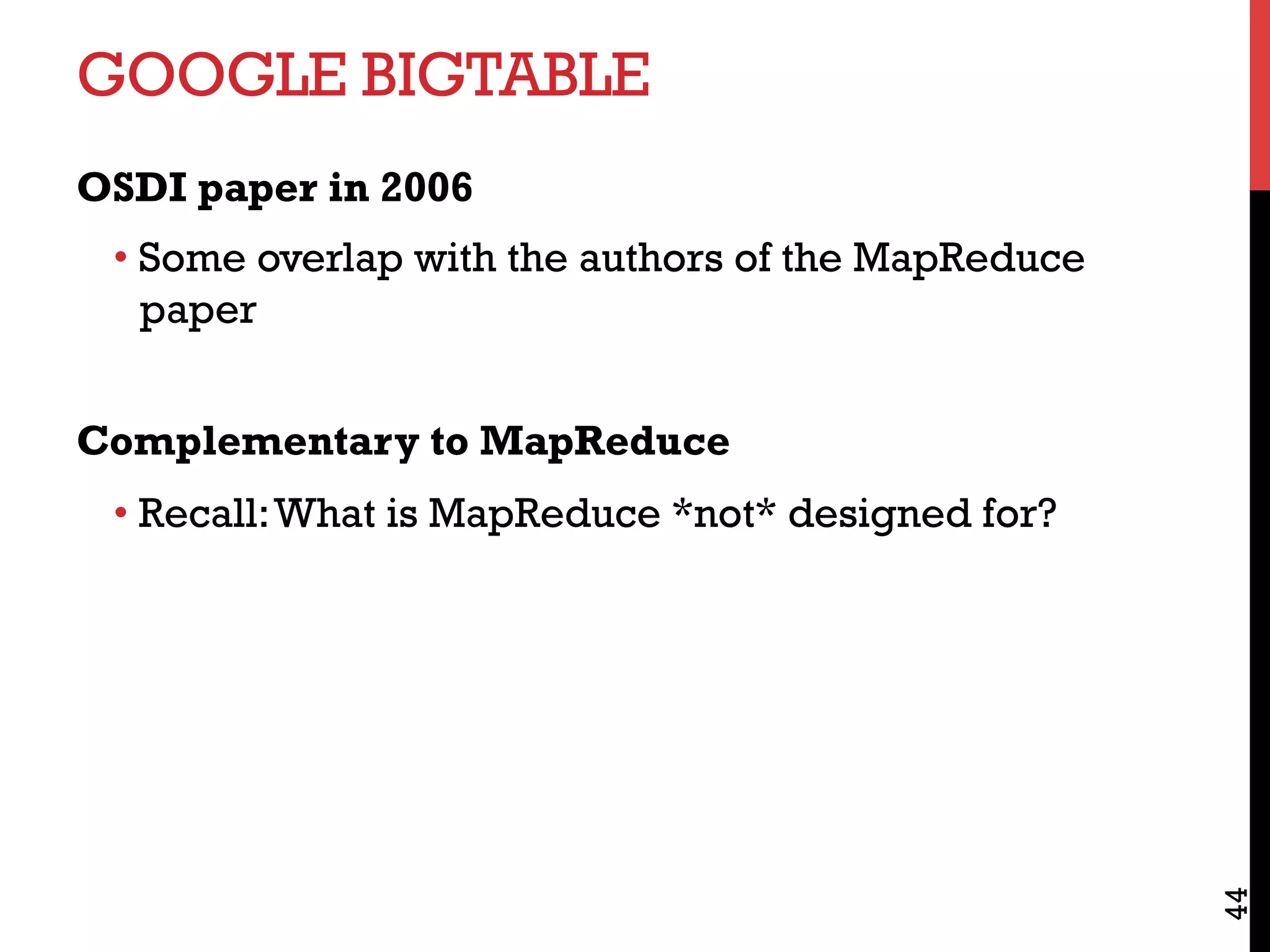
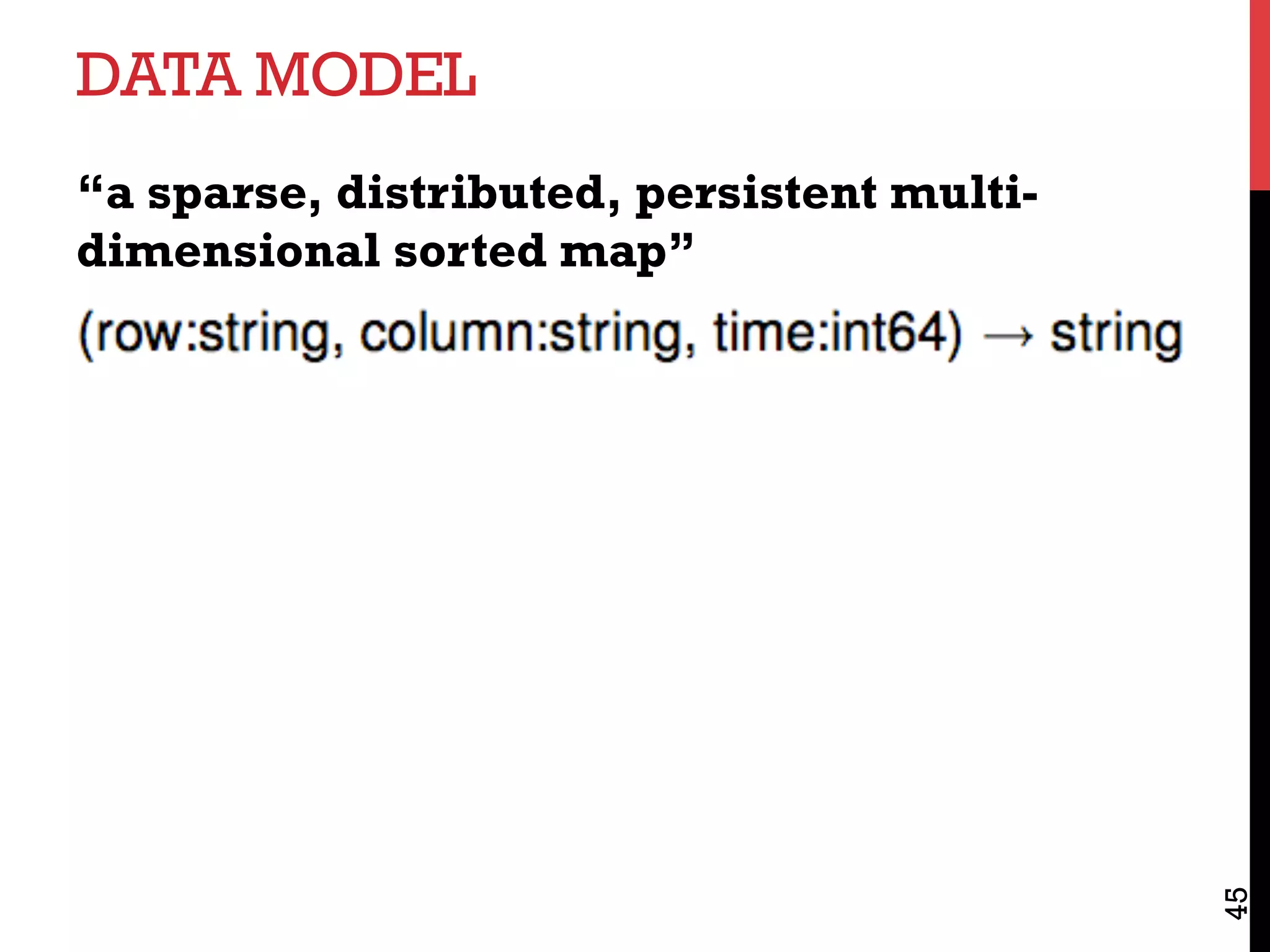
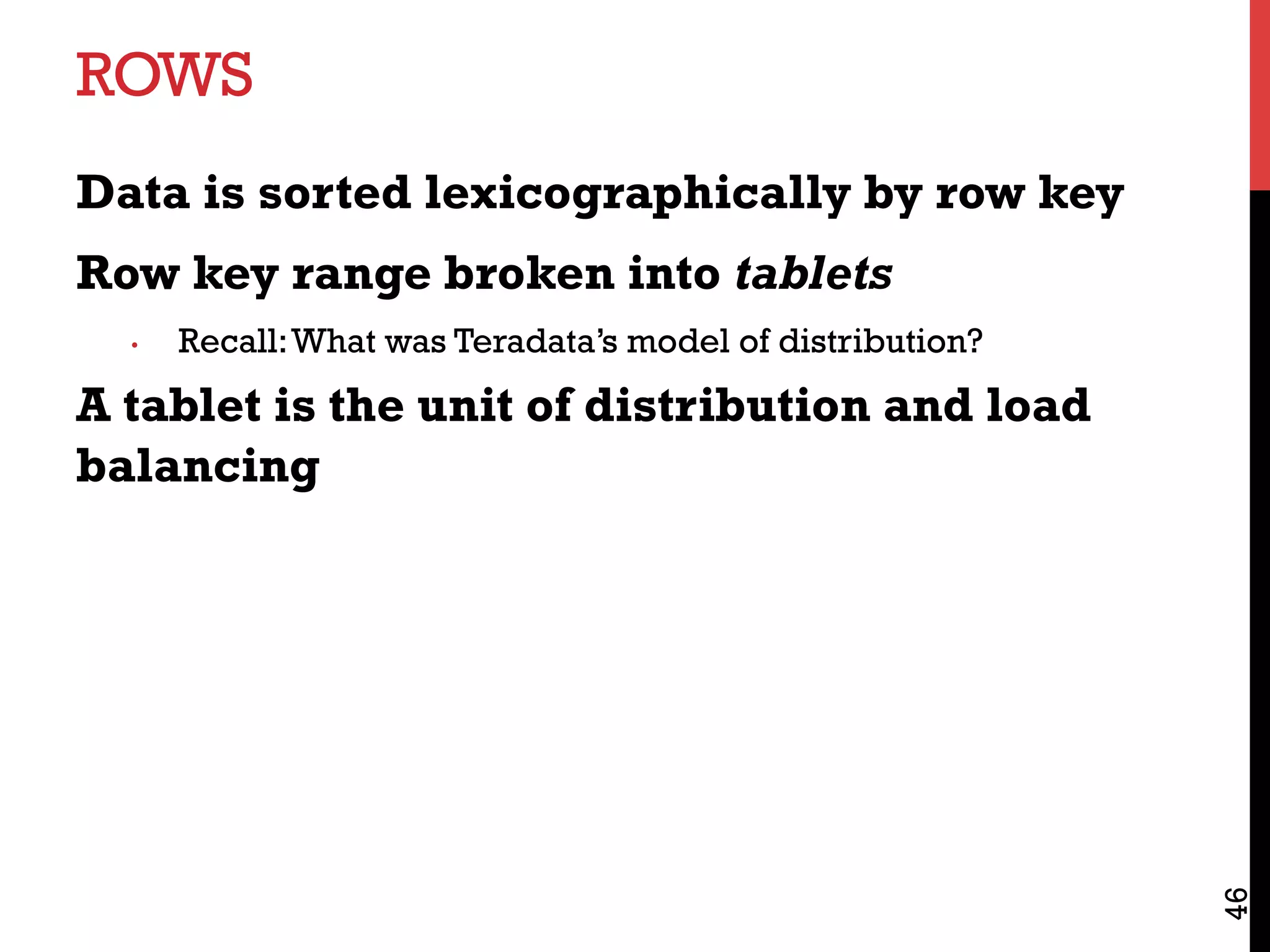



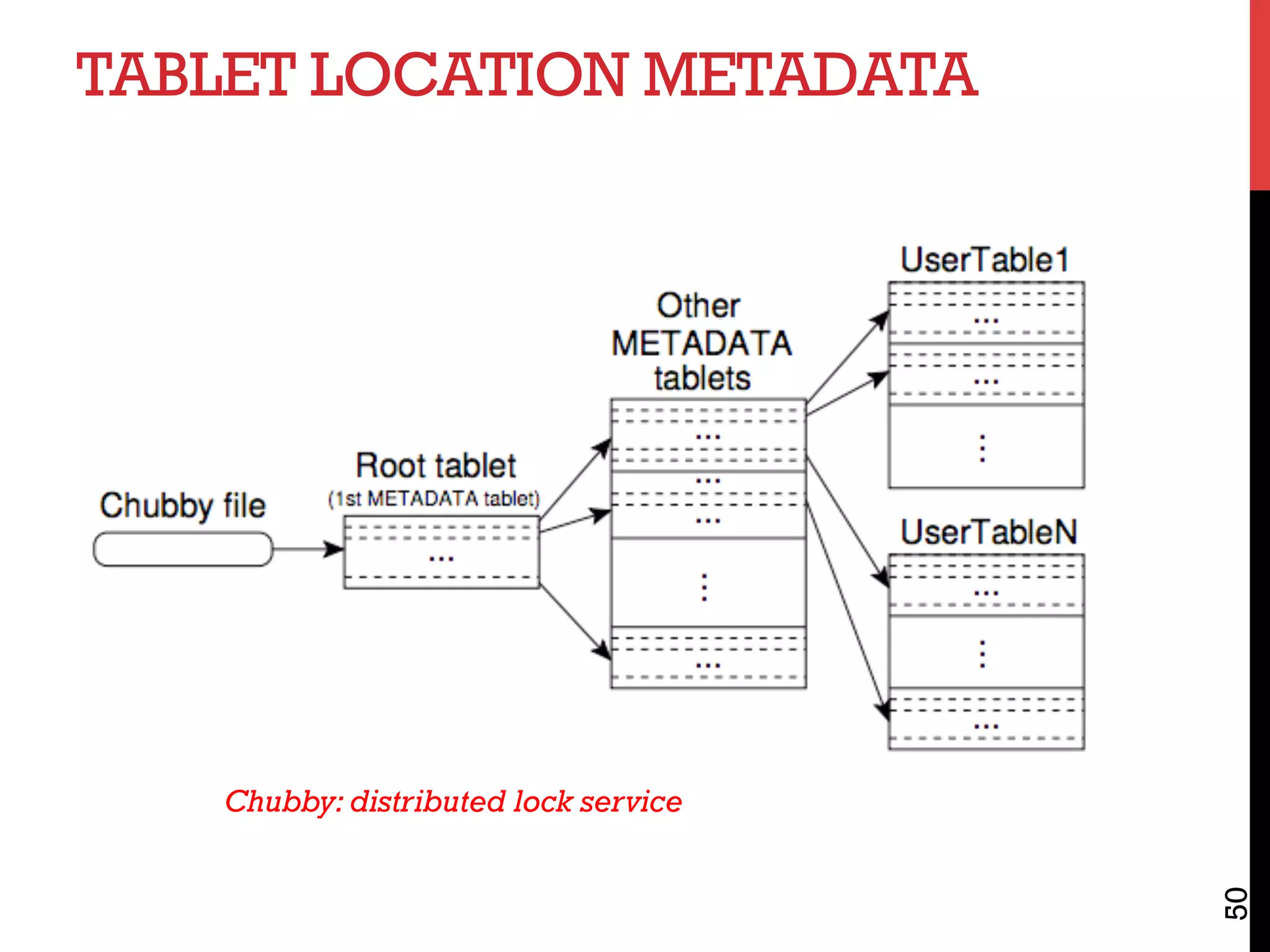
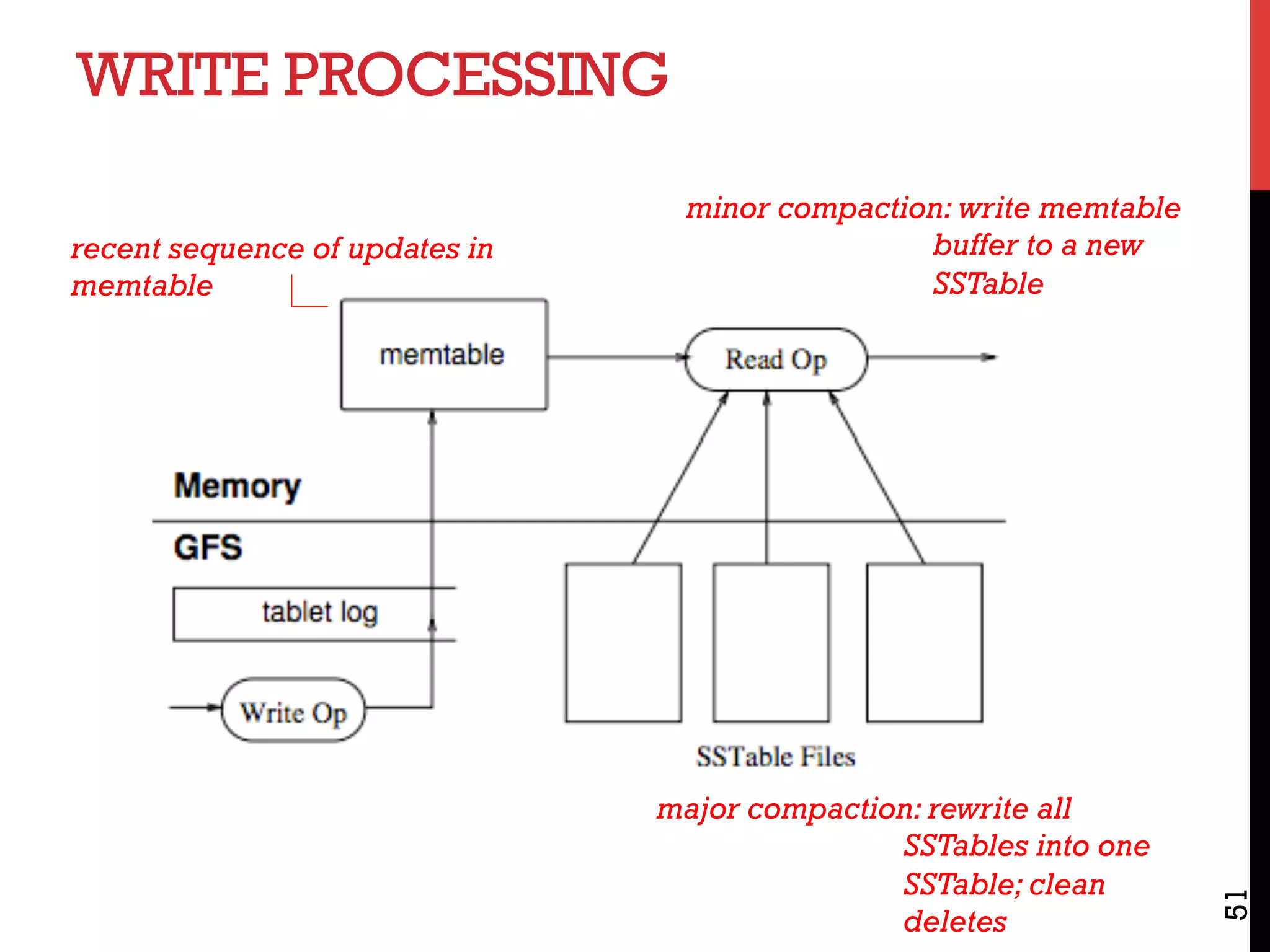






![CAP THEOREM [BREWER 2000,LYNCH 2002]
Consistency
• Do all applications see all the same data?
Availability
• If some nodes fail, does everything still work?
Partitioning
• If your nodes can’t talk to each other, does everything still work?
CAP Theorem: Choose two, or sacrifice latency
Databases: Consistency, Availability
NoSQL: Availability, Partitioning
But: Some counterevidence – “NewSQL”
58](https://image.slidesharecdn.com/billhowe4bigdatasystems-180131084727/75/Bill-howe-4_bigdatasystems-58-2048.jpg)




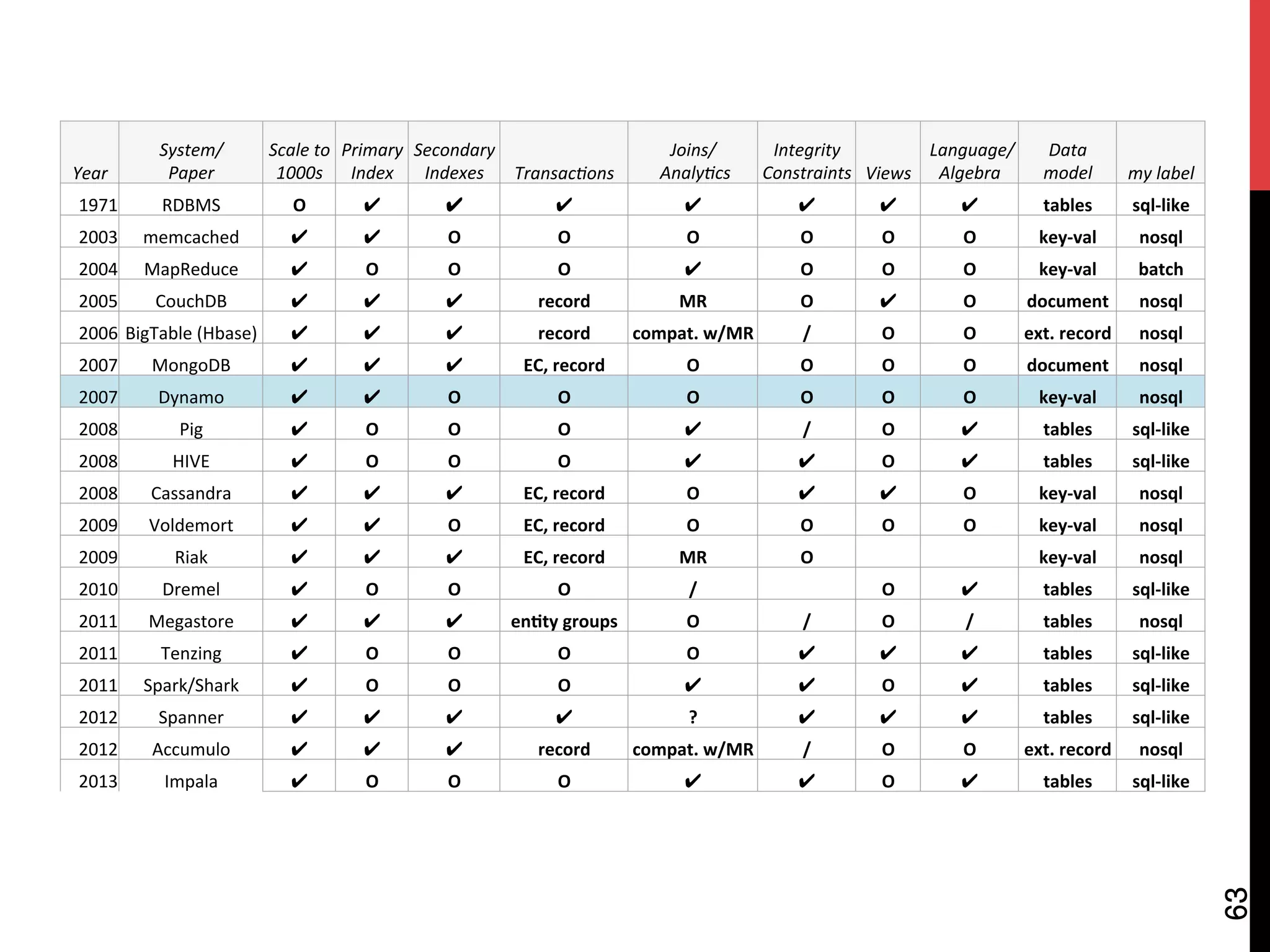
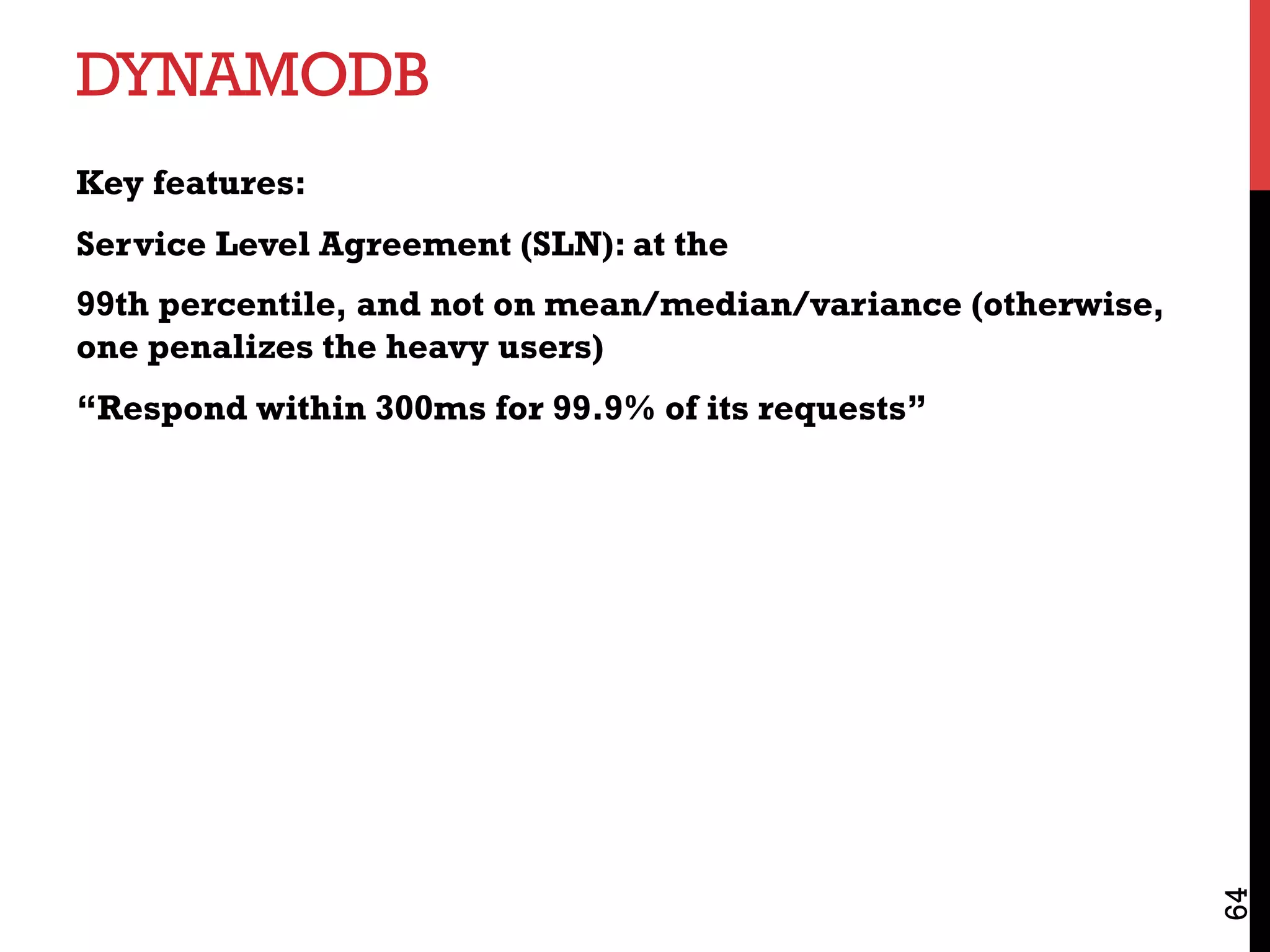

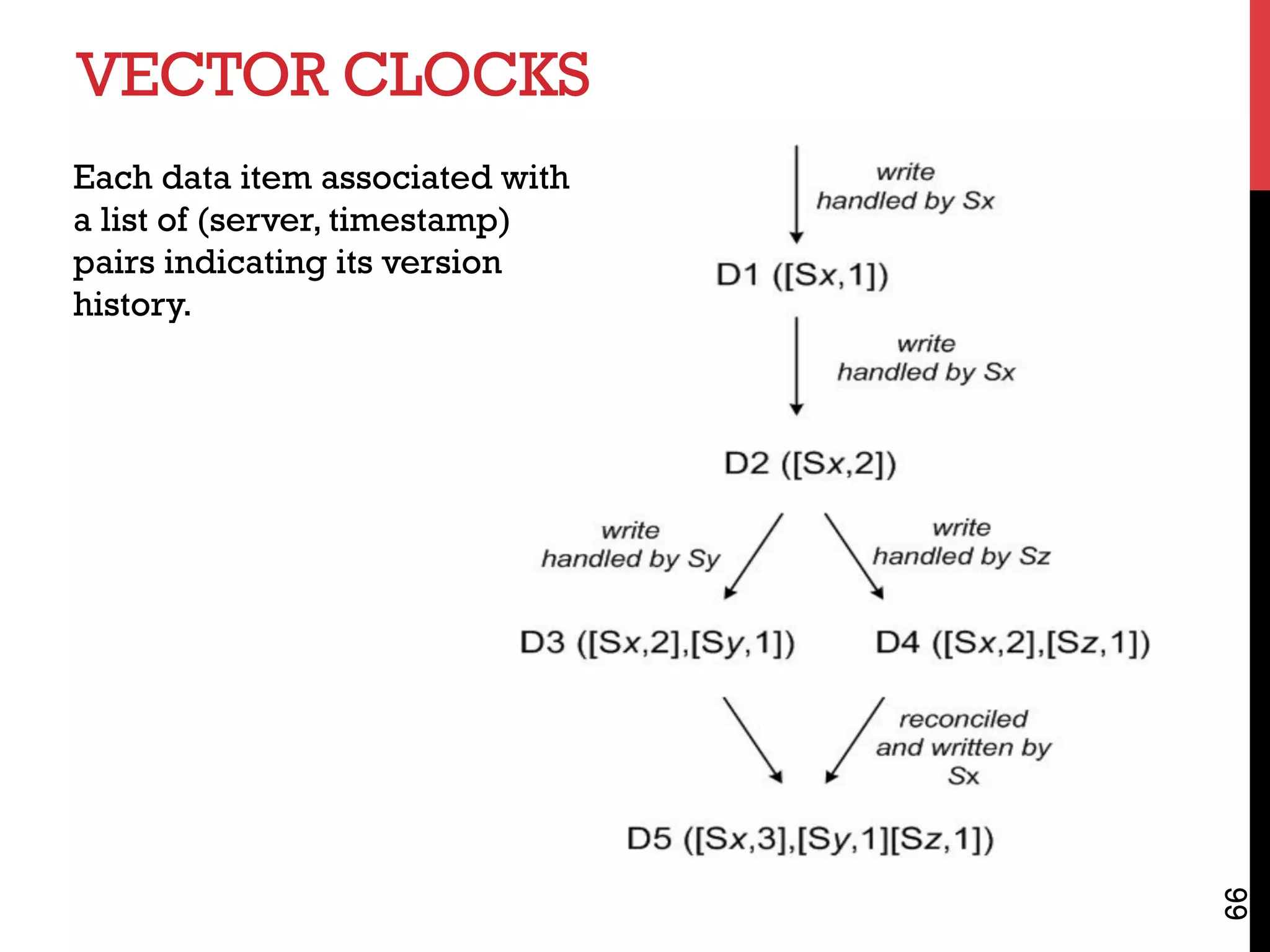
![VECTOR CLOCKS EXAMPLE
A client writes D1 at server SX:
D1 ([SX,1])
Another client reads D1, writes back D2; also handled by SX:
D2 ([SX,2]) (D1 garbage collected)
Another client reads D2, writes back D3; handled by server SY:
D3 ([SX,2], [SY,1])
Another client reads D2, writes back D4; handled by server SZ:
D4 ([SX,2], [SZ,1])
Another client reads D3, D4: CONFLICT !
67](https://image.slidesharecdn.com/billhowe4bigdatasystems-180131084727/75/Bill-howe-4_bigdatasystems-67-2048.jpg)
![68
Data 1 Data 2 Conflict?
([Sx,3],[Sy,6]) ([Sx,3],[Sz,2])
([Sx,3]) ([Sy,5])
([Sx,3],[Sy,6]) ([Sx,3],[Sy,6]),[Sz,2])
([Sx,3],[Sy,10])
([Sx,3],[Sy,10]) ([Sx,3],[Sy,20]),[Sz,2])
([Sx,3],[Sy,6]),[Sz,2])](https://image.slidesharecdn.com/billhowe4bigdatasystems-180131084727/75/Bill-howe-4_bigdatasystems-68-2048.jpg)

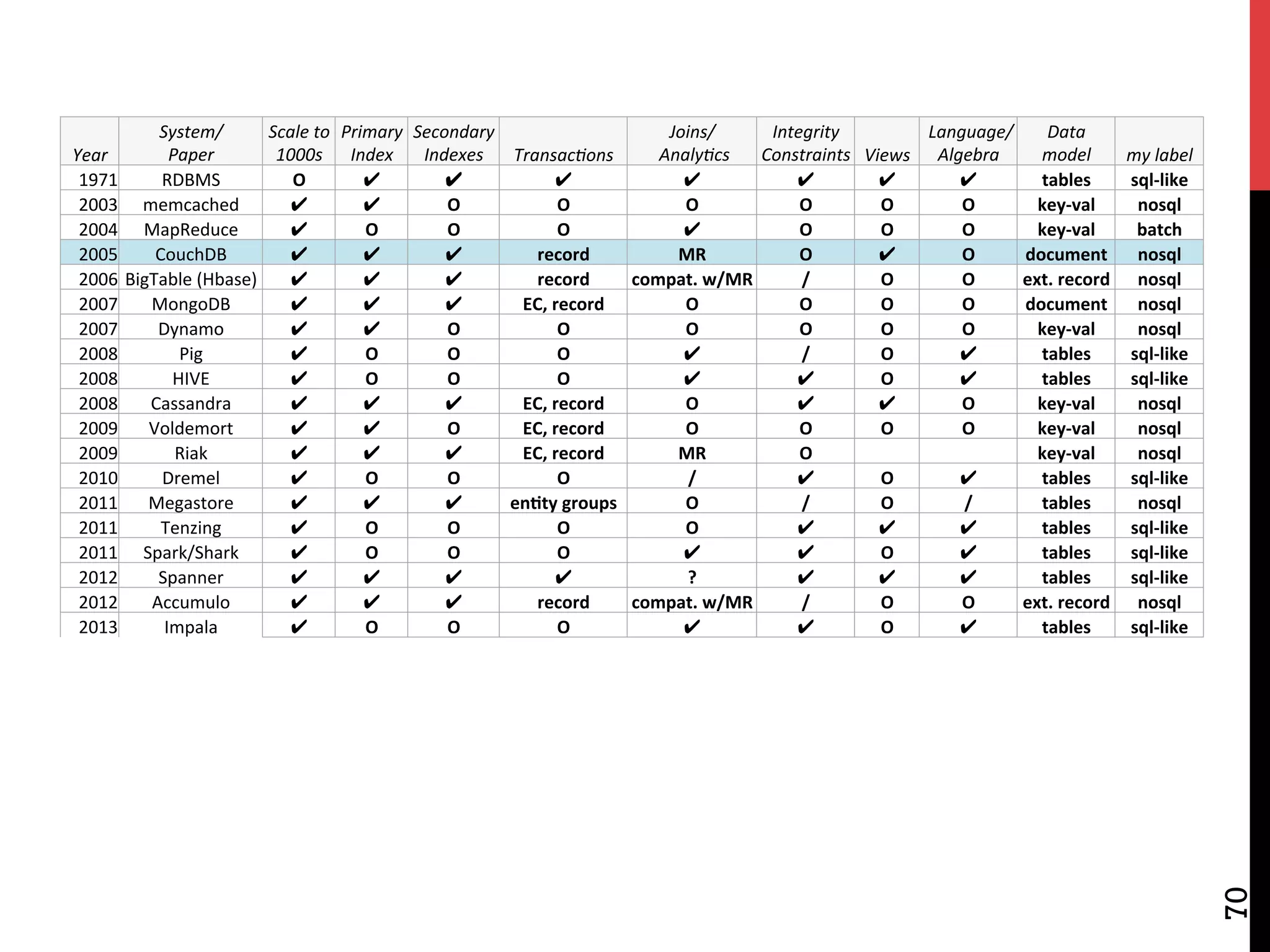
![COUCHDB:DATA MODEL
Document-oriented
• Document = set of key/value pairs
• Ex:
71
{
"Subject": "I like Plankton"
"Author": "Rusty"
"PostedDate": "5/23/2006"
"Tags": ["plankton", "baseball", "decisions"]
"Body": "I decided today that I don't like baseball. I
like plankton."
}](https://image.slidesharecdn.com/billhowe4bigdatasystems-180131084727/75/Bill-howe-4_bigdatasystems-71-2048.jpg)
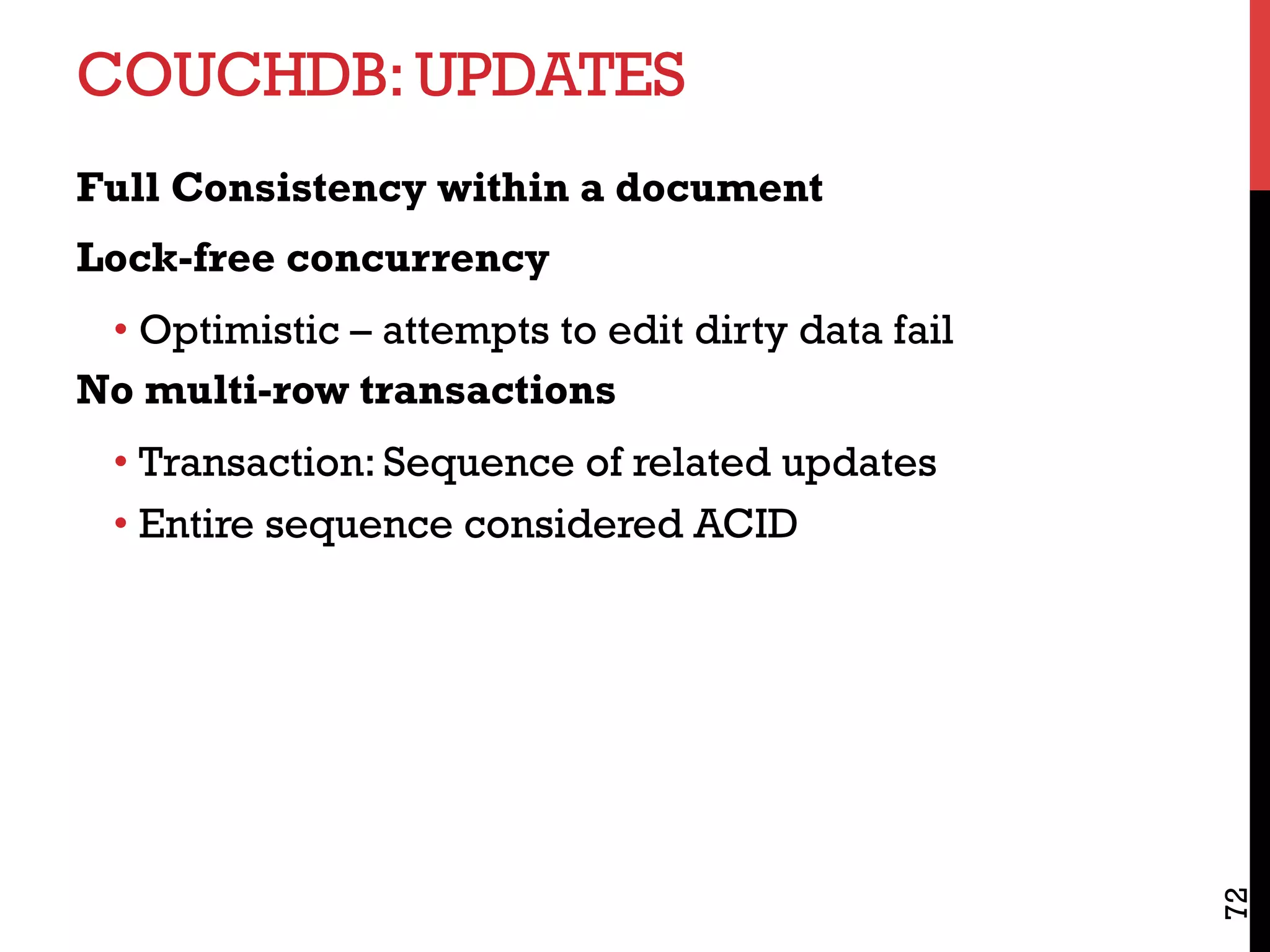

![COUCHDB“JOINS”
View Collation
74
function(doc) {
if (doc.type == "post") {
emit([doc._id, 0], doc);
} else if (doc.type == "comment") {
emit([doc.post, 1], doc);
}
}
my_view?startkey=[“some_post_id"]&endkey;=[“some_post_id", 2]](https://image.slidesharecdn.com/billhowe4bigdatasystems-180131084727/75/Bill-howe-4_bigdatasystems-74-2048.jpg)




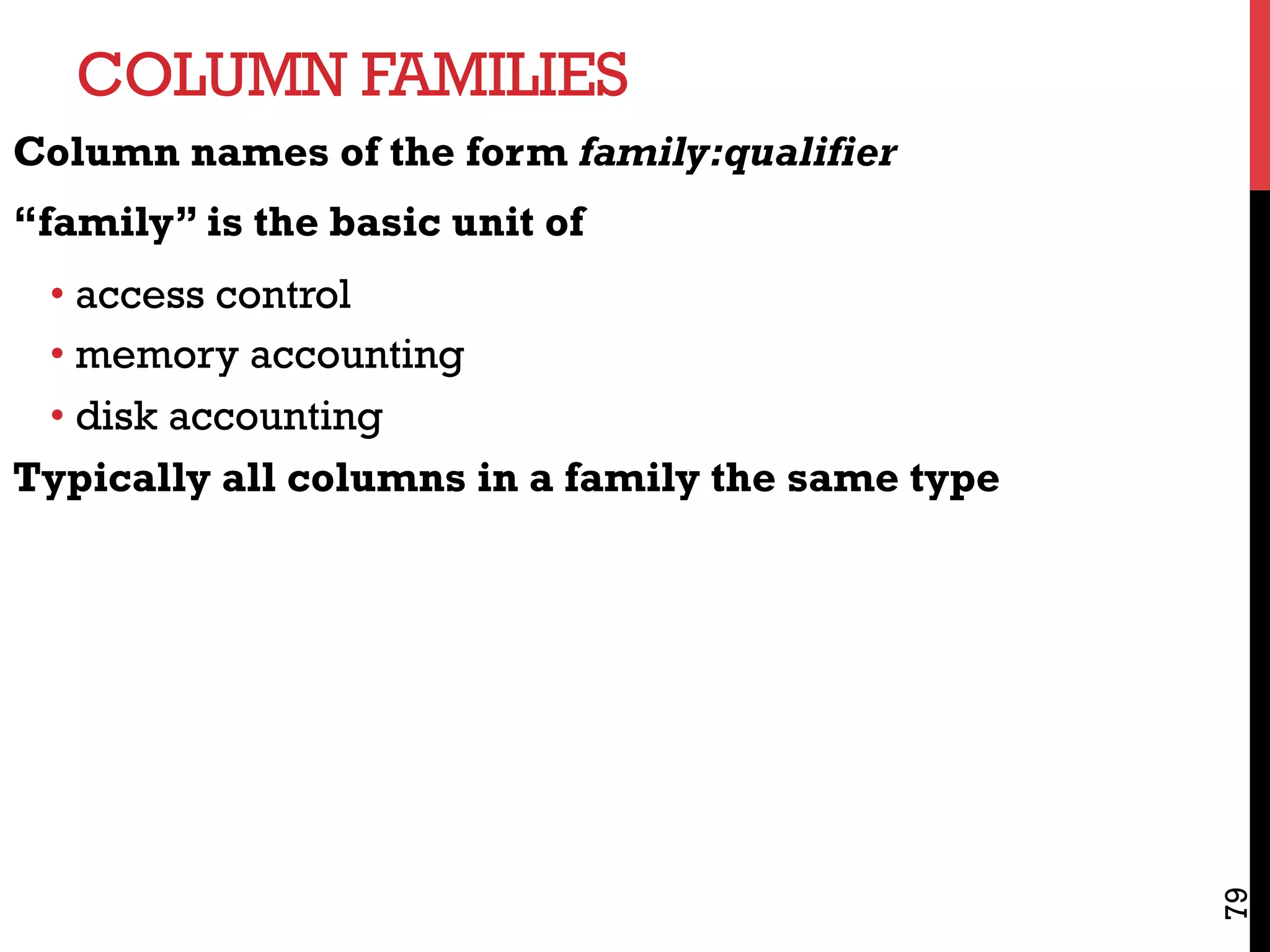


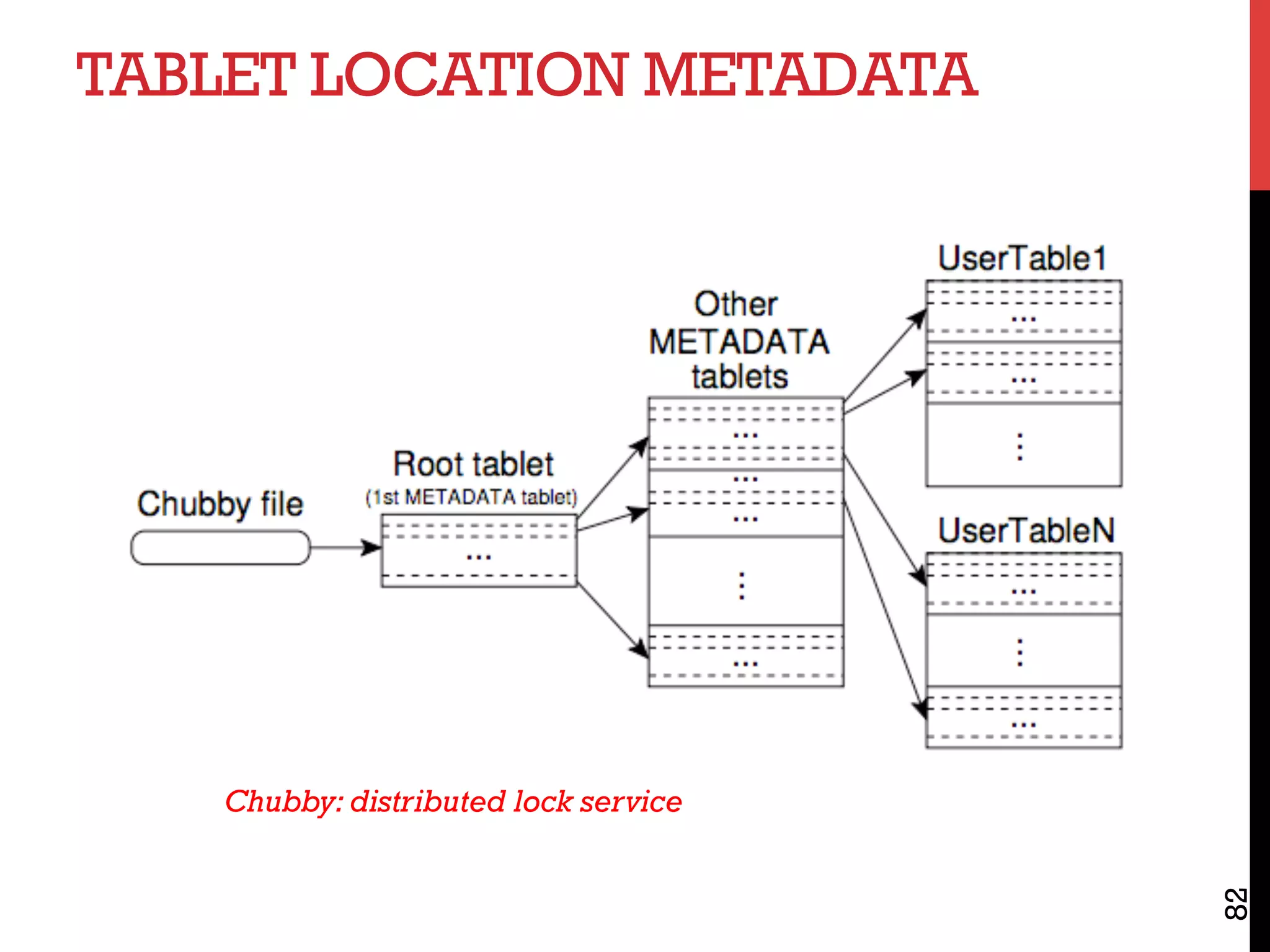
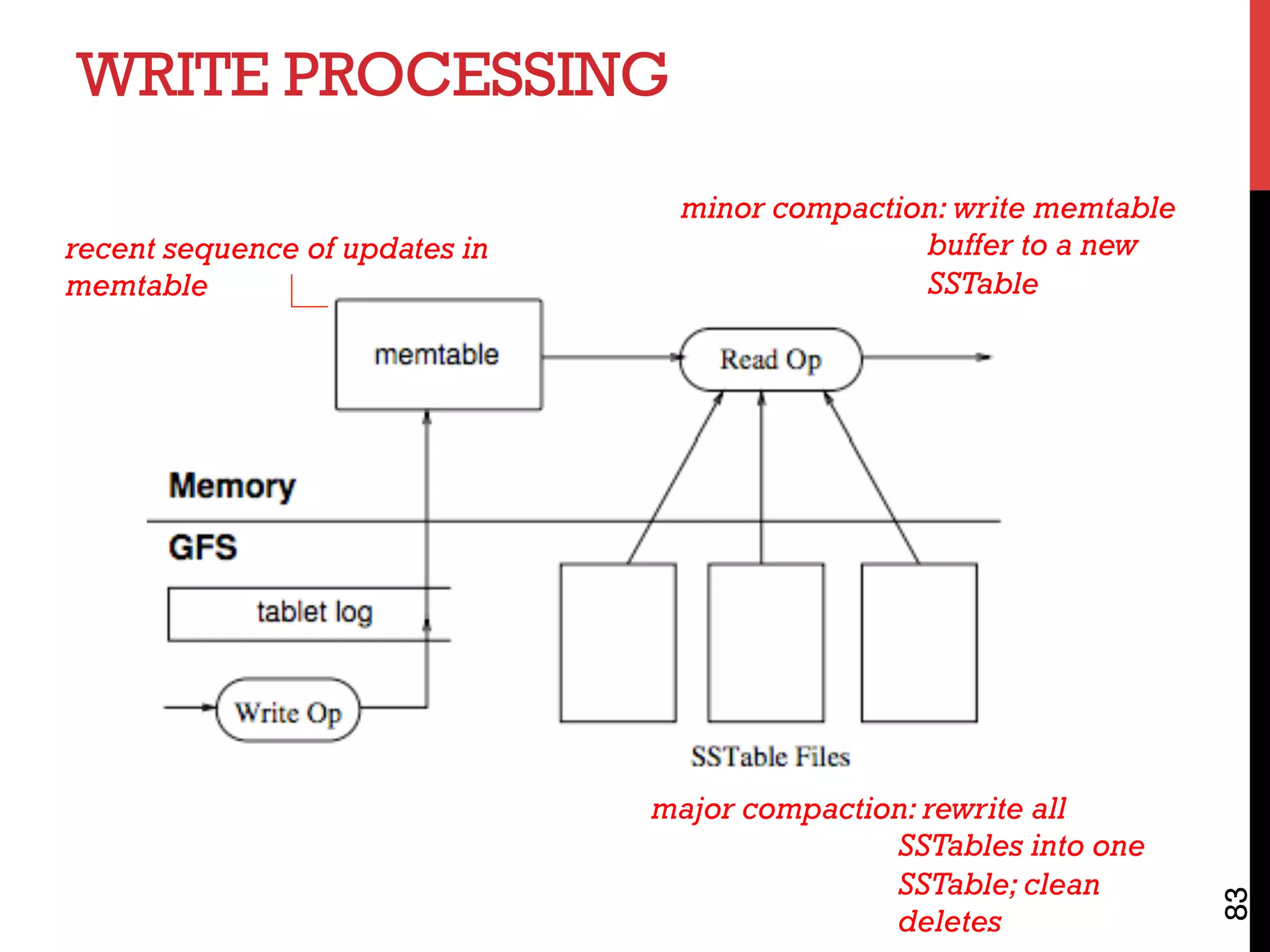


![MEGASTORE
Argues that loose consistency models complicate application
programming
Synchronous replication
Full transactions within a partition
86
[Baker, Bond, Corbett, et al. 2011]](https://image.slidesharecdn.com/billhowe4bigdatasystems-180131084727/75/Bill-howe-4_bigdatasystems-86-2048.jpg)
![SPANNER
87
Even though many projects happily use Bigtable [9], we have also
consistently received complaints from users that Bigtable can be
difficult to use for some kinds of applications: those that have
complex, evolving schemas, or those that want strong
consistency in the presence of wide-area replication.
“We believe it is better to have application programmers
deal with performance problems due to overuse of
transactions as bottlenecks arise, rather than always
coding around the lack of transactions.”
“Although Spanner is scalable in the number of nodes, the node-
local data structures have relatively poor performance on complex
SQL queries, because they were designed for simple key-value
accesses. Algorithms and data structures from DB literature could
improve singlenode performance a great deal.”](https://image.slidesharecdn.com/billhowe4bigdatasystems-180131084727/75/Bill-howe-4_bigdatasystems-87-2048.jpg)

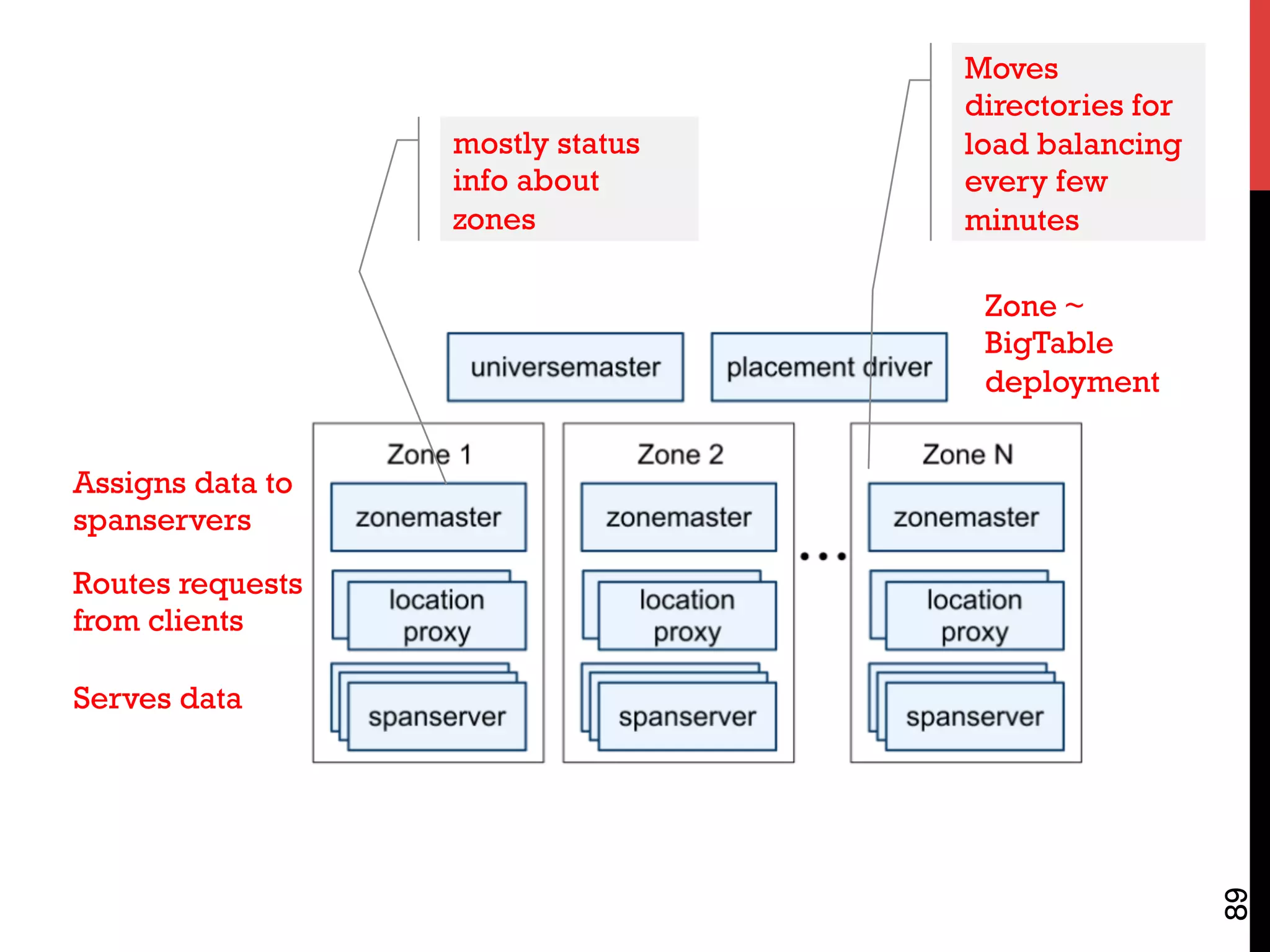


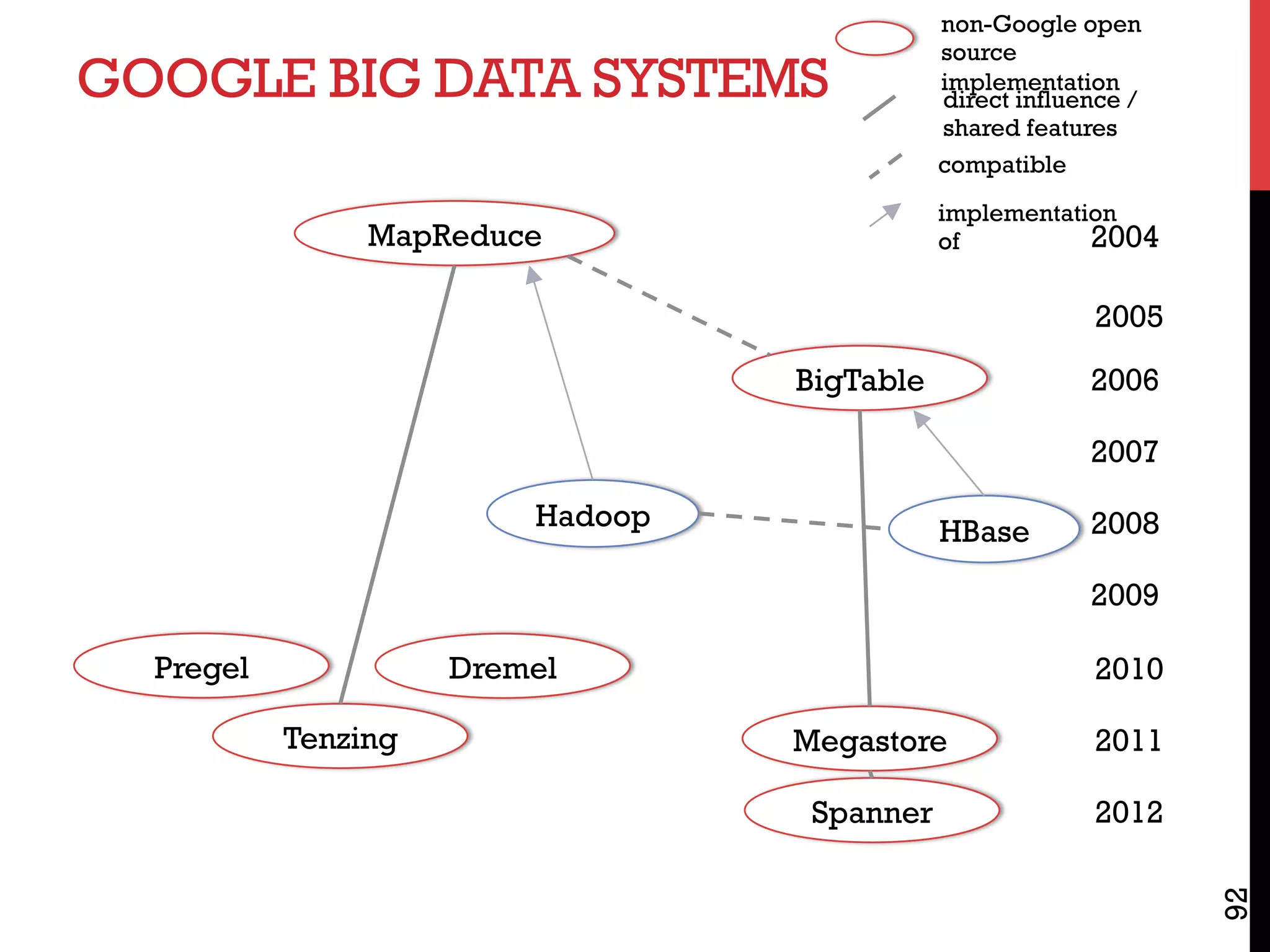
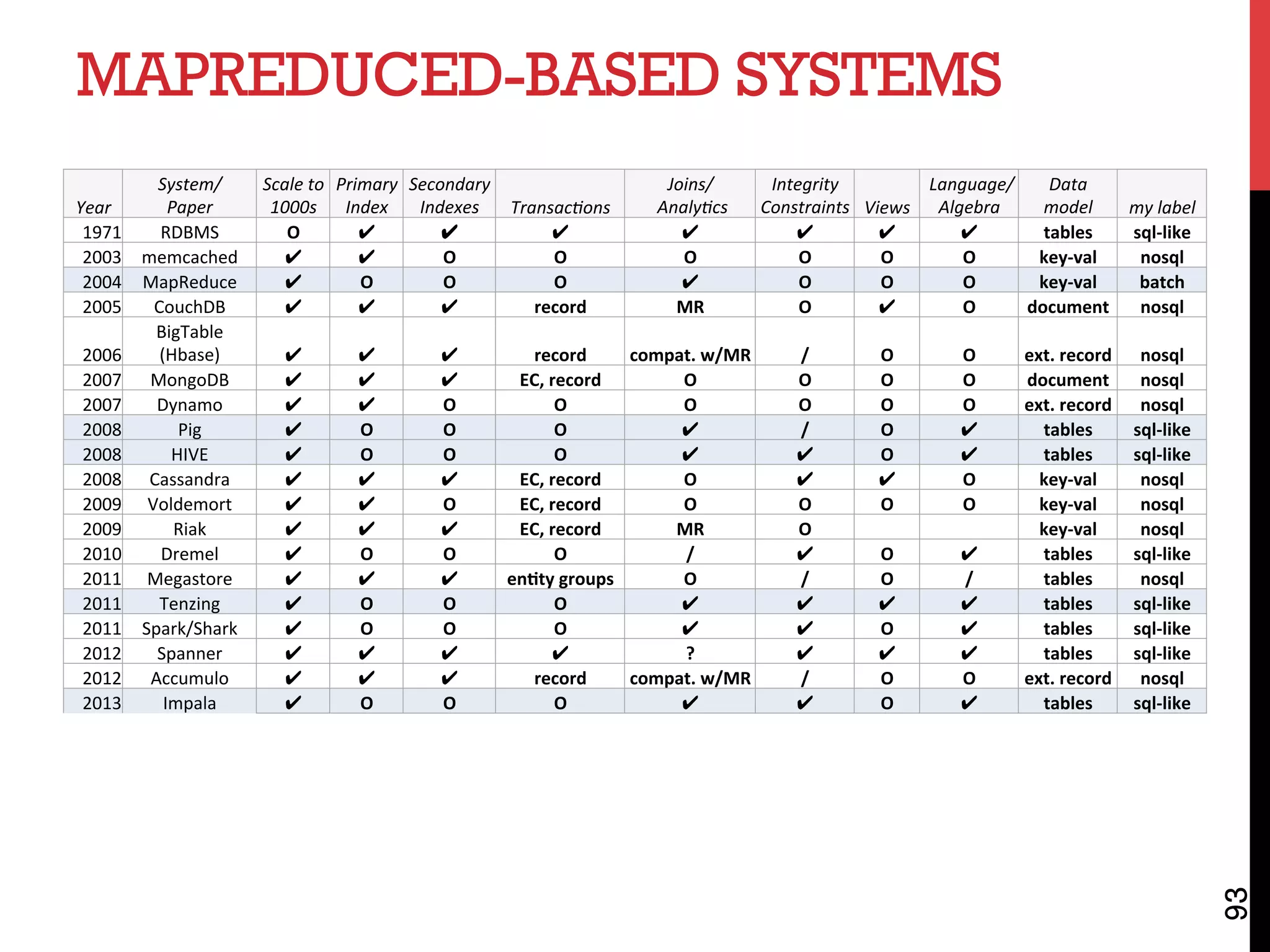



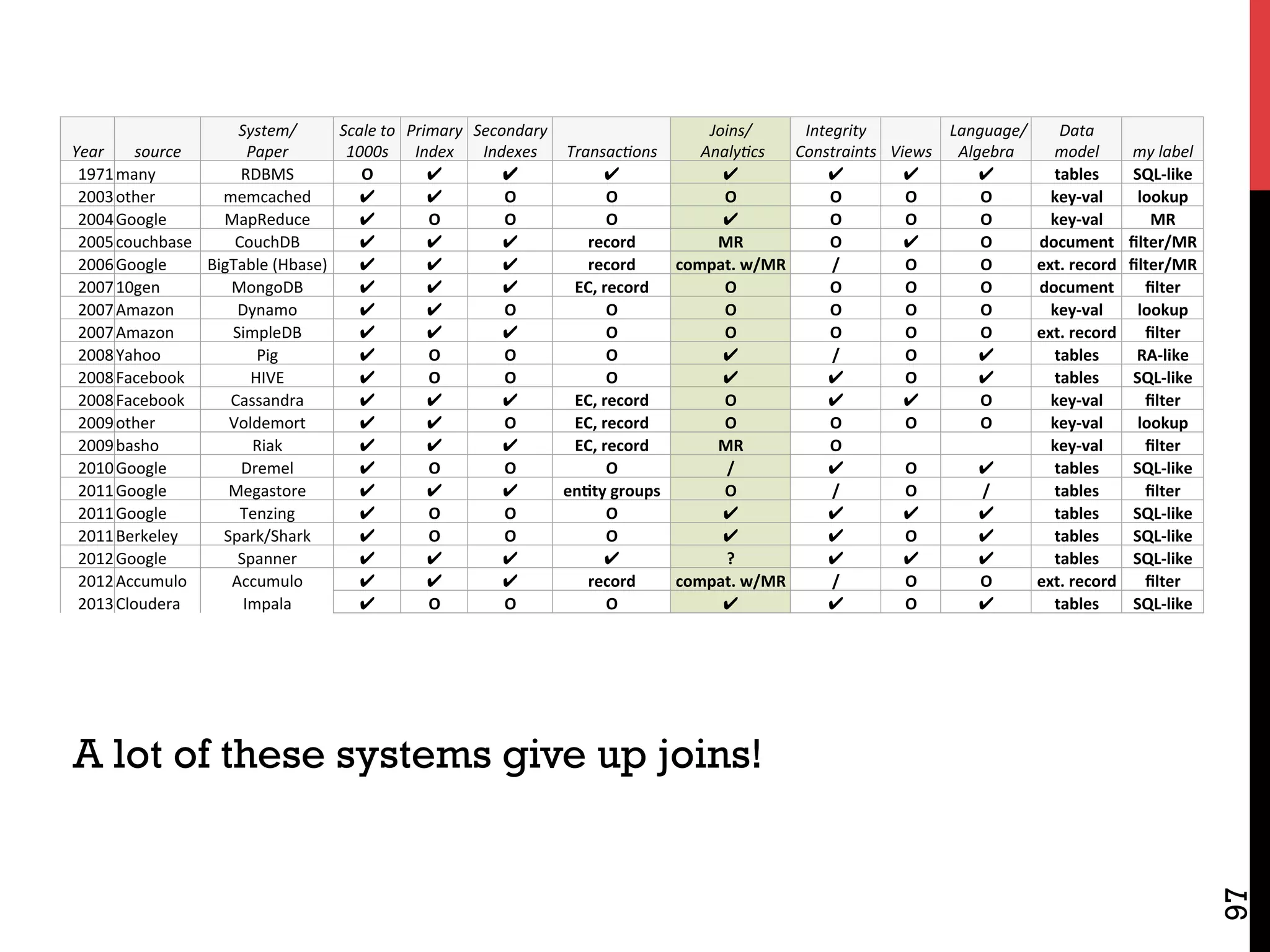
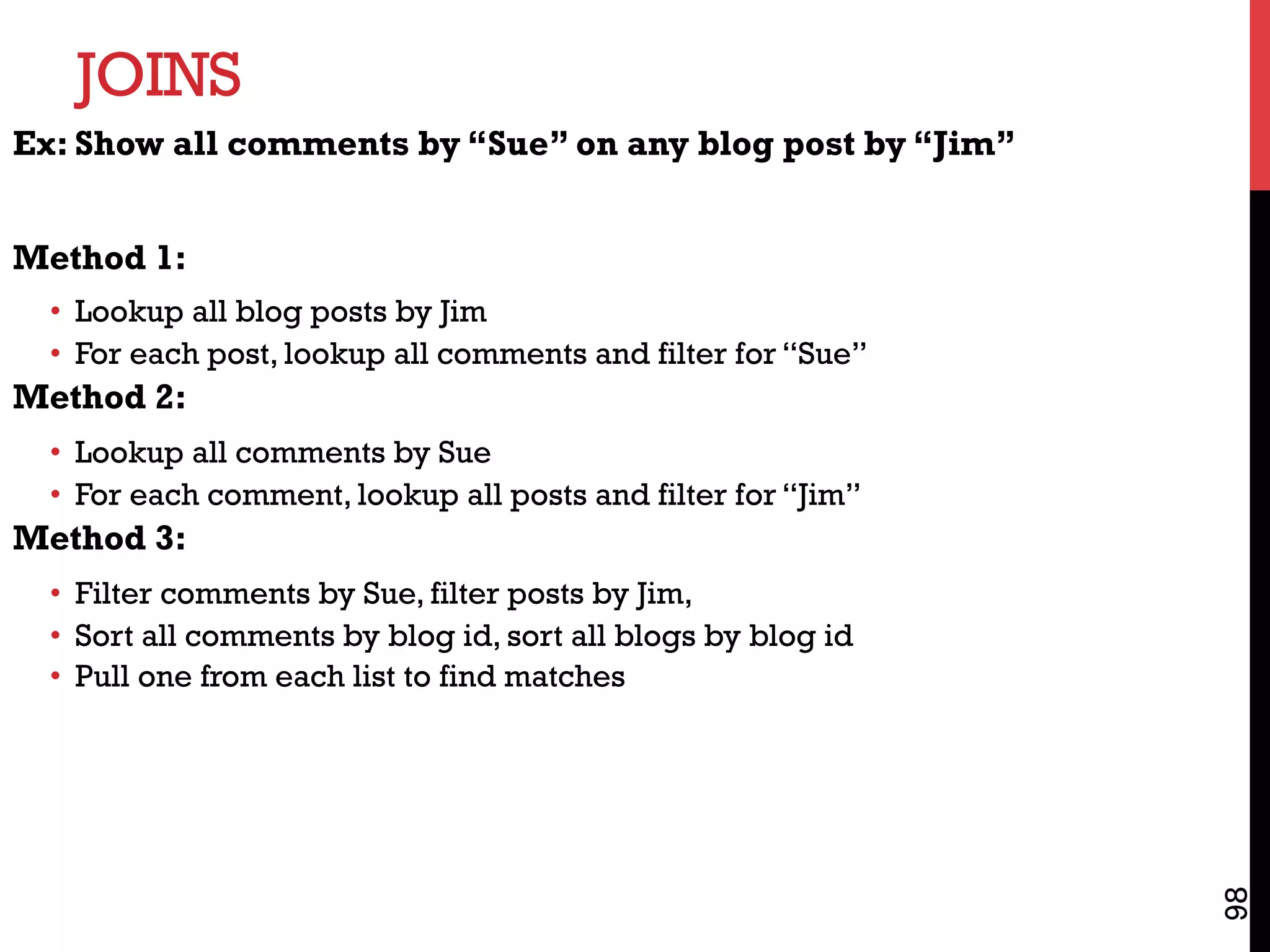
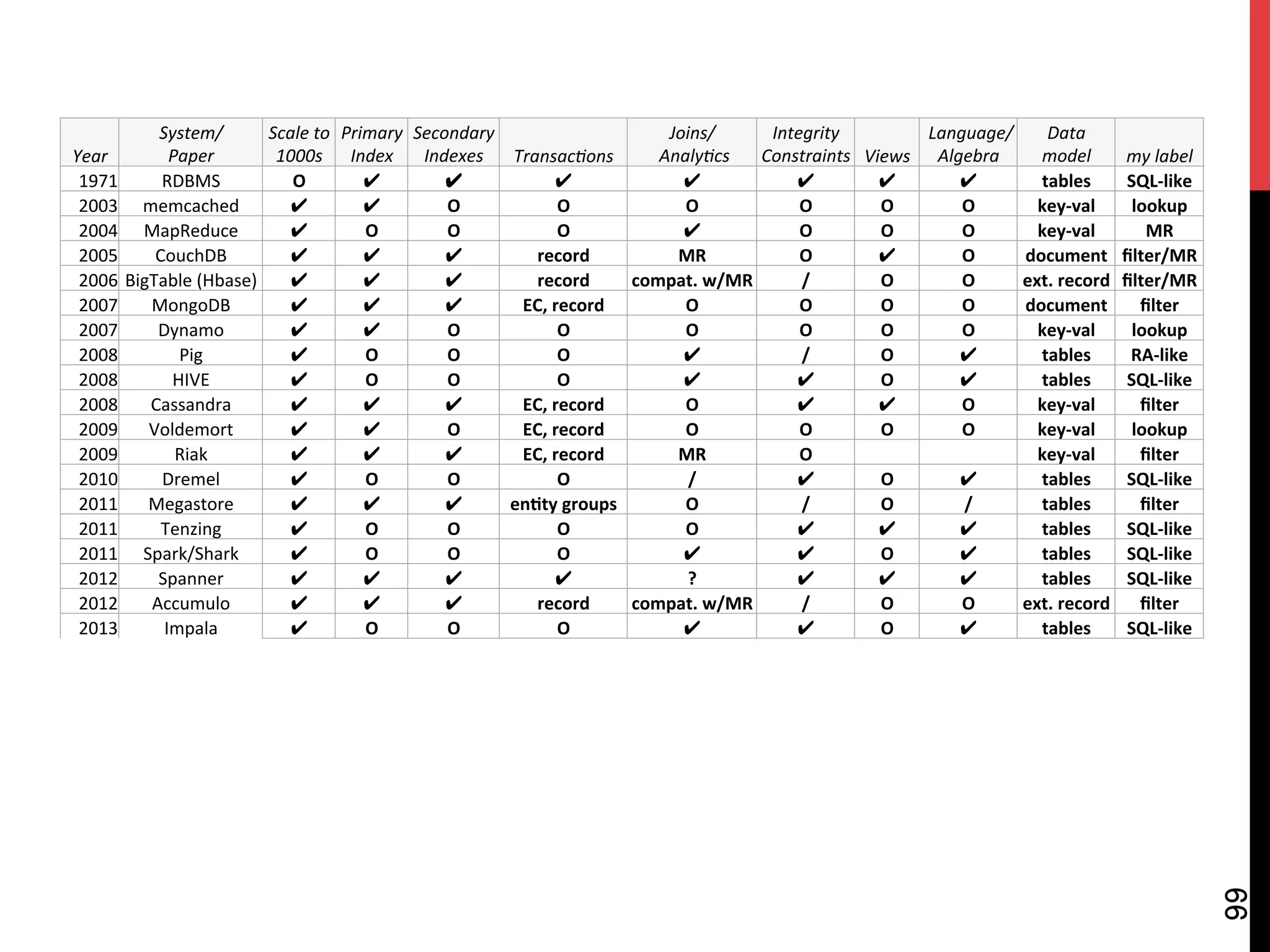
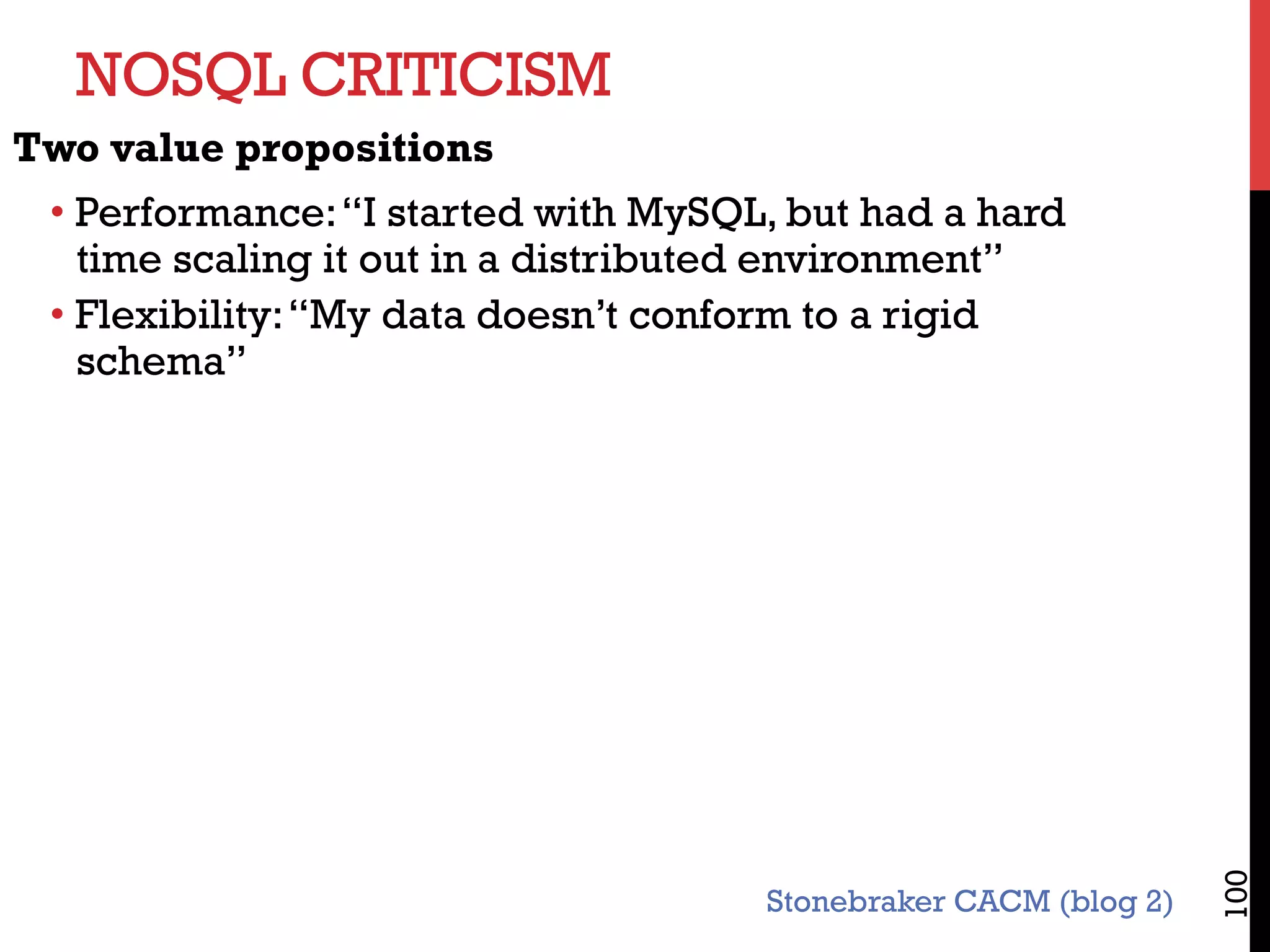



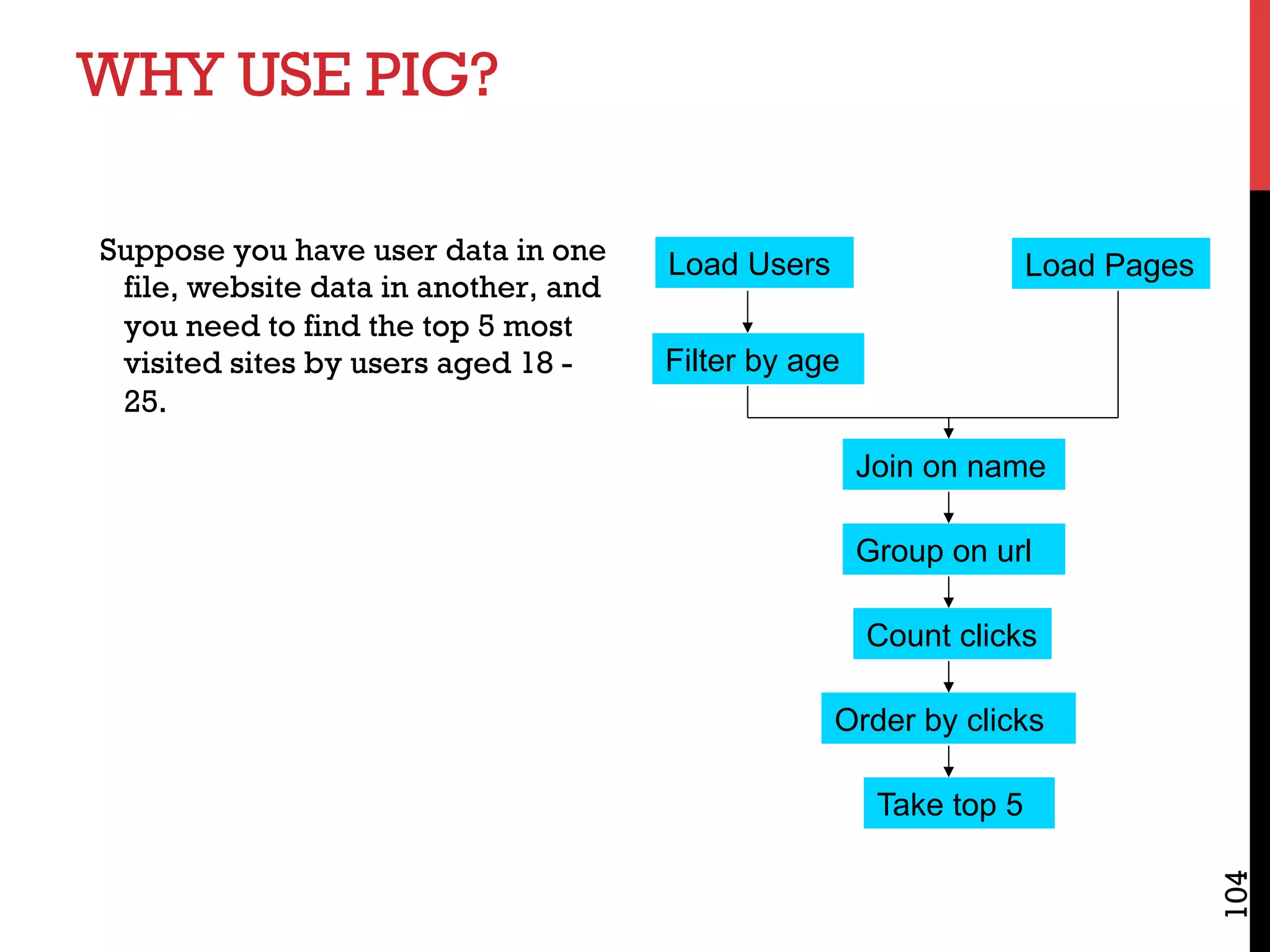
![IN MAPREDUCE
105
import java.io.IOException;
import java.util.ArrayList;
import java.util.Iterator;
import java.util.List;
import org.apache.hadoop.fs.Path;
import org.apache.hadoop.io.LongWritable;
import org.apache.hadoop.io.Text;
import org.apache.hadoop.io.Writable;
import org.apache.hadoop.io.WritableComparable;
import org.apache.hadoop.mapred.FileInputFormat;
import org.apache.hadoop.mapred.FileOutputFormat;
import org.apache.hadoop.mapred.JobConf;
import org.apache.hadoop.mapred.KeyValueTextInputFormat;
import org.apache.hadoop.mapred.Mapper;
import org.apache.hadoop.mapred.MapReduceBase;
import org.apache.hadoop.mapred.OutputCollector;
import org.apache.hadoop.mapred.RecordReader;
import org.apache.hadoop.mapred.Reducer;
import org.apache.hadoop.mapred.Reporter;
import org.apache.hadoop.mapred.SequenceFileInputFormat;
import org.apache.hadoop.mapred.SequenceFileOutputFormat;
import org.apache.hadoop.mapred.TextInputFormat;
import org.apache.hadoop.mapred.jobcontrol.Job;
import org.apache.hadoop.mapred.jobcontrol.JobControl;
import org.apache.hadoop.mapred.lib.IdentityMapper;
public class MRExample {
public static class LoadPages extends MapReduceBase
implements Mapper<LongWritable, Text, Text, Text> {
public void map(LongWritable k, Text val,
OutputCollector<Text, Text> oc,
Reporter reporter) throws IOException {
// Pull the key out
String line = val.toString();
int firstComma = line.indexOf(',');
String key = line.substring(0, firstComma);
String value = line.substring(firstComma + 1);
Text outKey = new Text(key);
// Prepend an index to the value so we know which file
// it came from.
Text outVal = new Text("1" + value);
oc.collect(outKey, outVal);
}
}
public static class LoadAndFilterUsers extends MapReduceBase
implements Mapper<LongWritable, Text, Text, Text> {
public void map(LongWritable k, Text val,
OutputCollector<Text, Text> oc,
Reporter reporter) throws IOException {
// Pull the key out
String line = val.toString();
int firstComma = line.indexOf(',');
String value = line.substring(firstComma + 1);
int age = Integer.parseInt(value);
if (age < 18 || age > 25) return;
String key = line.substring(0, firstComma);
Text outKey = new Text(key);
// Prepend an index to the value so we know which file
// it came from.
Text outVal = new Text("2" + value);
oc.collect(outKey, outVal);
}
}
public static class Join extends MapReduceBase
implements Reducer<Text, Text, Text, Text> {
public void reduce(Text key,
Iterator<Text> iter,
OutputCollector<Text, Text> oc,
Reporter reporter) throws IOException {
// For each value, figure out which file it's from and
store it
// accordingly.
List<String> first = new ArrayList<String>();
List<String> second = new ArrayList<String>();
while (iter.hasNext()) {
Text t = iter.next();
String value = t.toString();
if (value.charAt(0) == '1')
first.add(value.substring(1));
else second.add(value.substring(1));
reporter.setStatus("OK");
}
// Do the cross product and collect the values
for (String s1 : first) {
for (String s2 : second) {
String outval = key + "," + s1 + "," + s2;
oc.collect(null, new Text(outval));
reporter.setStatus("OK");
}
}
}
}
public static class LoadJoined extends MapReduceBase
implements Mapper<Text, Text, Text, LongWritable> {
public void map(
Text k,
Text val,
OutputCollector<Text, LongWritable> oc,
Reporter reporter) throws IOException {
// Find the url
String line = val.toString();
int firstComma = line.indexOf(',');
int secondComma = line.indexOf(',', firstComma);
String key = line.substring(firstComma, secondComma);
// drop the rest of the record, I don't need it anymore,
// just pass a 1 for the combiner/reducer to sum instead.
Text outKey = new Text(key);
oc.collect(outKey, new LongWritable(1L));
}
}
public static class ReduceUrls extends MapReduceBase
implements Reducer<Text, LongWritable, WritableComparable,
Writable> {
public void reduce(
Text key,
Iterator<LongWritable> iter,
OutputCollector<WritableComparable, Writable> oc,
Reporter reporter) throws IOException {
// Add up all the values we see
long sum = 0;
while (iter.hasNext()) {
sum += iter.next().get();
reporter.setStatus("OK");
}
oc.collect(key, new LongWritable(sum));
}
}
public static class LoadClicks extends MapReduceBase
implements Mapper<WritableComparable, Writable, LongWritable,
Text> {
public void map(
WritableComparable key,
Writable val,
OutputCollector<LongWritable, Text> oc,
Reporter reporter) throws IOException {
oc.collect((LongWritable)val, (Text)key);
}
}
public static class LimitClicks extends MapReduceBase
implements Reducer<LongWritable, Text, LongWritable, Text> {
int count = 0;
public void reduce(
LongWritable key,
Iterator<Text> iter,
OutputCollector<LongWritable, Text> oc,
Reporter reporter) throws IOException {
// Only output the first 100 records
while (count < 100 && iter.hasNext()) {
oc.collect(key, iter.next());
count++;
}
}
}
public static void main(String[] args) throws IOException {
JobConf lp = new JobConf(MRExample.class);
lp.setJobName("Load Pages");
lp.setInputFormat(TextInputFormat.class);
lp.setOutputKeyClass(Text.class);
lp.setOutputValueClass(Text.class);
lp.setMapperClass(LoadPages.class);
FileInputFormat.addInputPath(lp, new
Path("/user/gates/pages"));
FileOutputFormat.setOutputPath(lp,
new Path("/user/gates/tmp/indexed_pages"));
lp.setNumReduceTasks(0);
Job loadPages = new Job(lp);
JobConf lfu = new JobConf(MRExample.class);
lfu.setJobName("Load and Filter Users");
lfu.setInputFormat(TextInputFormat.class);
lfu.setOutputKeyClass(Text.class);
lfu.setOutputValueClass(Text.class);
lfu.setMapperClass(LoadAndFilterUsers.class);
FileInputFormat.addInputPath(lfu, new
Path("/user/gates/users"));
FileOutputFormat.setOutputPath(lfu,
new Path("/user/gates/tmp/filtered_users"));
lfu.setNumReduceTasks(0);
Job loadUsers = new Job(lfu);
JobConf join = new JobConf(MRExample.class);
join.setJobName("Join Users and Pages");
join.setInputFormat(KeyValueTextInputFormat.class);
join.setOutputKeyClass(Text.class);
join.setOutputValueClass(Text.class);
join.setMapperClass(IdentityMapper.class);
join.setReducerClass(Join.class);
FileInputFormat.addInputPath(join, new
Path("/user/gates/tmp/indexed_pages"));
FileInputFormat.addInputPath(join, new
Path("/user/gates/tmp/filtered_users"));
FileOutputFormat.setOutputPath(join, new
Path("/user/gates/tmp/joined"));
join.setNumReduceTasks(50);
Job joinJob = new Job(join);
joinJob.addDependingJob(loadPages);
joinJob.addDependingJob(loadUsers);
JobConf group = new JobConf(MRExample.class);
group.setJobName("Group URLs");
group.setInputFormat(KeyValueTextInputFormat.class);
group.setOutputKeyClass(Text.class);
group.setOutputValueClass(LongWritable.class);
group.setOutputFormat(SequenceFileOutputFormat.class);
group.setMapperClass(LoadJoined.class);
group.setCombinerClass(ReduceUrls.class);
group.setReducerClass(ReduceUrls.class);
FileInputFormat.addInputPath(group, new
Path("/user/gates/tmp/joined"));
FileOutputFormat.setOutputPath(group, new
Path("/user/gates/tmp/grouped"));
group.setNumReduceTasks(50);
Job groupJob = new Job(group);
groupJob.addDependingJob(joinJob);
JobConf top100 = new JobConf(MRExample.class);
top100.setJobName("Top 100 sites");
top100.setInputFormat(SequenceFileInputFormat.class);
top100.setOutputKeyClass(LongWritable.class);
top100.setOutputValueClass(Text.class);
top100.setOutputFormat(SequenceFileOutputFormat.class);
top100.setMapperClass(LoadClicks.class);
top100.setCombinerClass(LimitClicks.class);
top100.setReducerClass(LimitClicks.class);
FileInputFormat.addInputPath(top100, new
Path("/user/gates/tmp/grouped"));
FileOutputFormat.setOutputPath(top100, new
Path("/user/gates/top100sitesforusers18to25"));
top100.setNumReduceTasks(1);
Job limit = new Job(top100);
limit.addDependingJob(groupJob);
JobControl jc = new JobControl("Find top 100 sites for users
18 to 25");
jc.addJob(loadPages);
jc.addJob(loadUsers);
jc.addJob(joinJob);
jc.addJob(groupJob);
jc.addJob(limit);
jc.run();
}
}
170 lines of code, 4 hours to write](https://image.slidesharecdn.com/billhowe4bigdatasystems-180131084727/75/Bill-howe-4_bigdatasystems-105-2048.jpg)




![110
<1, {<2,3>,<4,6>,<5,7>}, ['apache':'search']>](https://image.slidesharecdn.com/billhowe4bigdatasystems-180131084727/75/Bill-howe-4_bigdatasystems-110-2048.jpg)
![111
t = <1, {<2,3>,<4,6>,<5,7>}, ['apache':'search']>
Each field has a name, possibly derived from the operator
f1:atom f2:bag f3:map](https://image.slidesharecdn.com/billhowe4bigdatasystems-180131084727/75/Bill-howe-4_bigdatasystems-111-2048.jpg)
![112
t = <1, {<2,3>,<4,6>,<5,7>}, ['apache':'search']>
f1:atom f2:bag f3:map
expression result
$0 1
f2 Bag {<2,3>,<4,6>,<5,7>}
f2.$0 Bag {<2>,<4>,<5>}
f3#’apache’ Atom “search”
sum(f2.$0) 2+4+5](https://image.slidesharecdn.com/billhowe4bigdatasystems-180131084727/75/Bill-howe-4_bigdatasystems-112-2048.jpg)
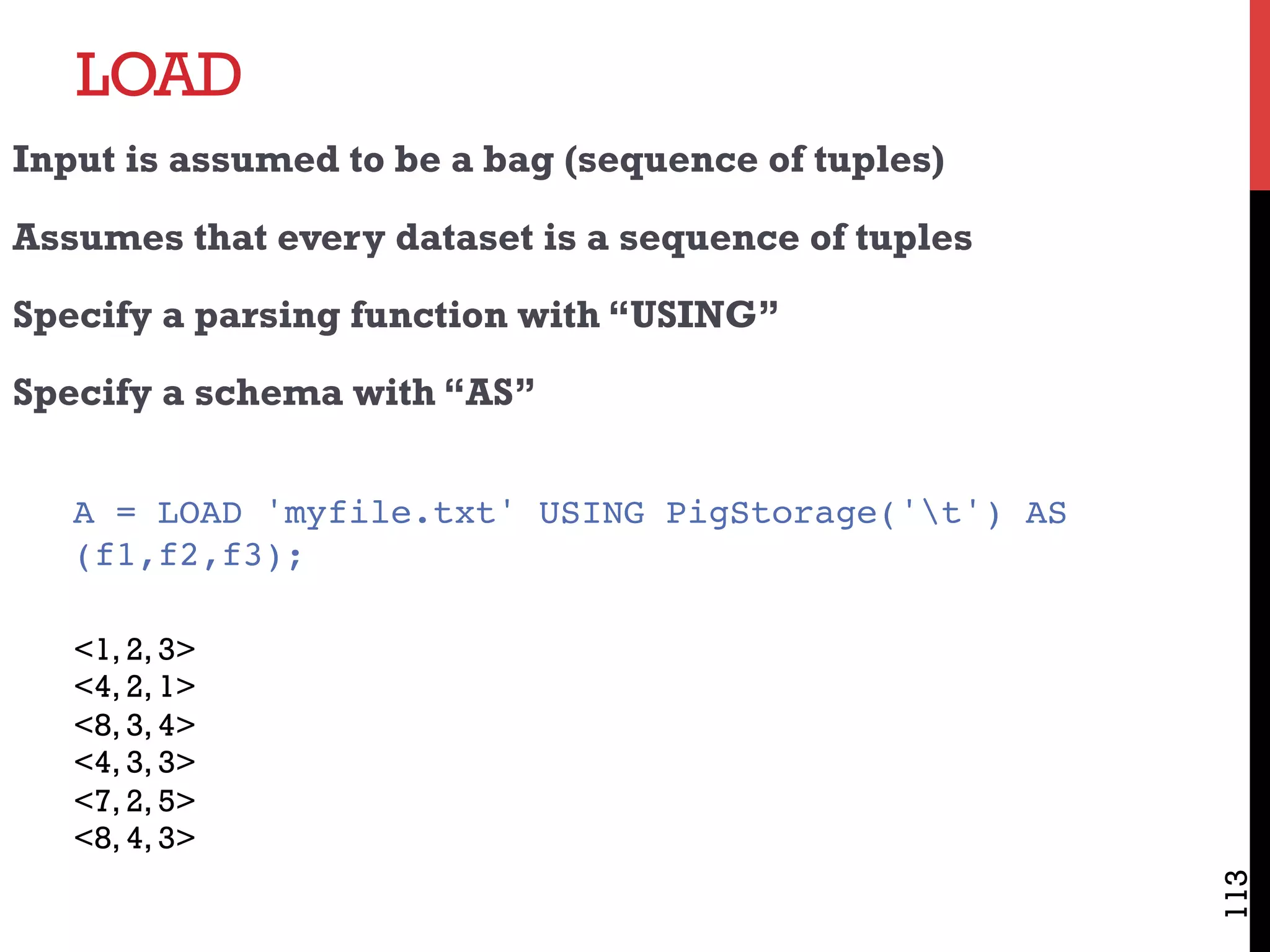
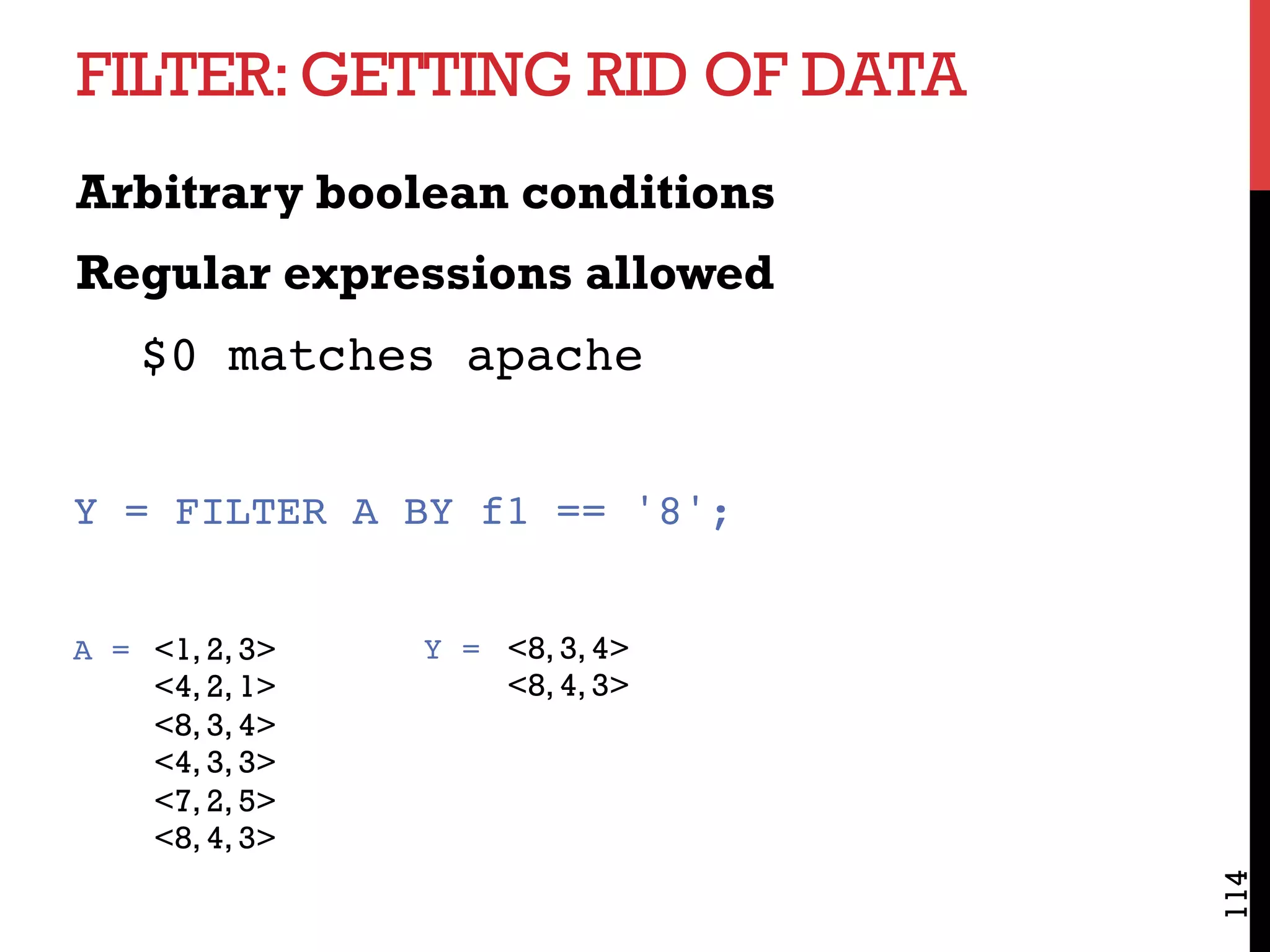



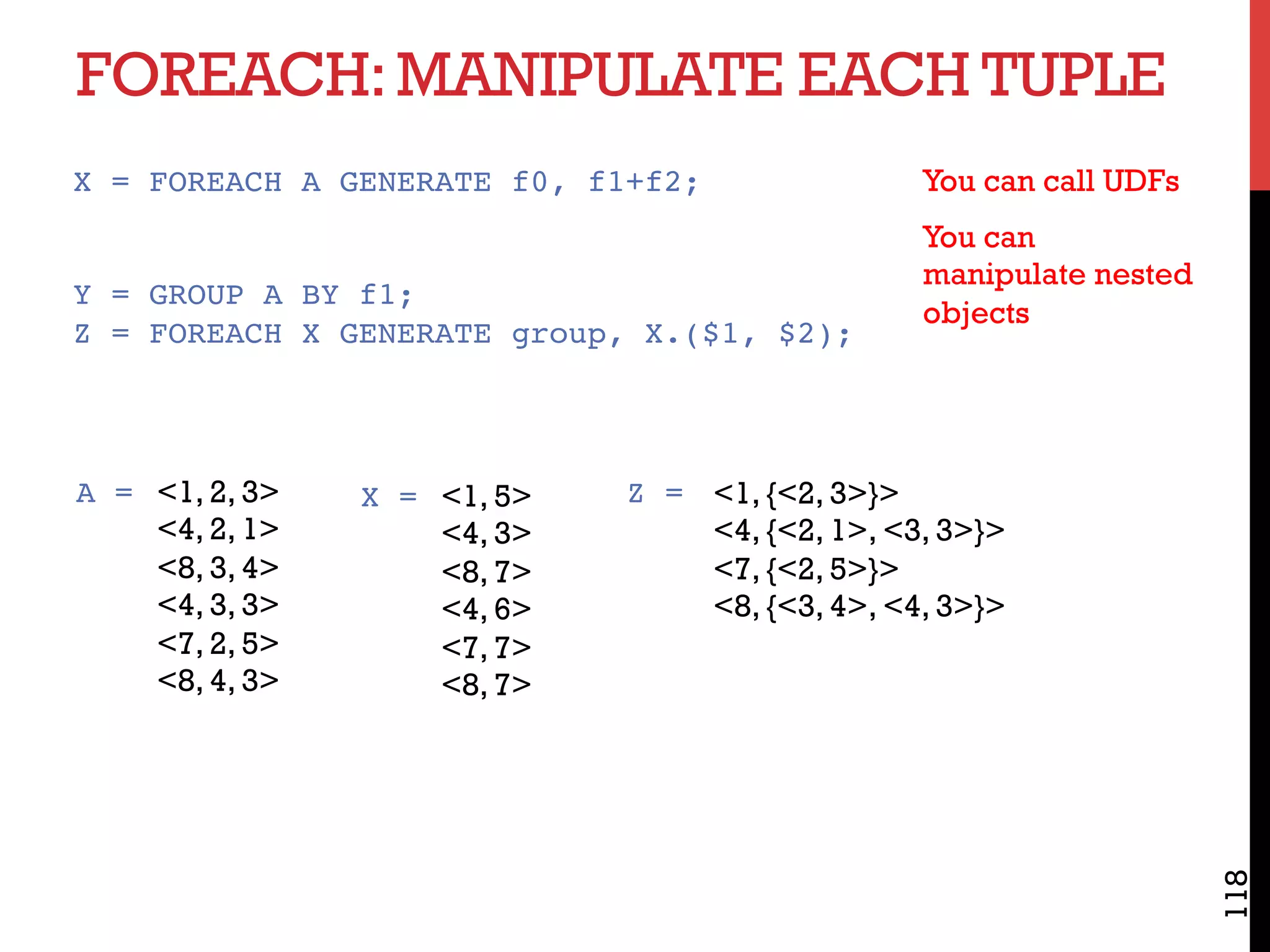

![IN MAPREDUCE
120
import java.io.IOException;
import java.util.ArrayList;
import java.util.Iterator;
import java.util.List;
import org.apache.hadoop.fs.Path;
import org.apache.hadoop.io.LongWritable;
import org.apache.hadoop.io.Text;
import org.apache.hadoop.io.Writable;
import org.apache.hadoop.io.WritableComparable;
import org.apache.hadoop.mapred.FileInputFormat;
import org.apache.hadoop.mapred.FileOutputFormat;
import org.apache.hadoop.mapred.JobConf;
import org.apache.hadoop.mapred.KeyValueTextInputFormat;
import org.apache.hadoop.mapred.Mapper;
import org.apache.hadoop.mapred.MapReduceBase;
import org.apache.hadoop.mapred.OutputCollector;
import org.apache.hadoop.mapred.RecordReader;
import org.apache.hadoop.mapred.Reducer;
import org.apache.hadoop.mapred.Reporter;
import org.apache.hadoop.mapred.SequenceFileInputFormat;
import org.apache.hadoop.mapred.SequenceFileOutputFormat;
import org.apache.hadoop.mapred.TextInputFormat;
import org.apache.hadoop.mapred.jobcontrol.Job;
import org.apache.hadoop.mapred.jobcontrol.JobControl;
import org.apache.hadoop.mapred.lib.IdentityMapper;
public class MRExample {
public static class LoadPages extends MapReduceBase
implements Mapper<LongWritable, Text, Text, Text> {
public void map(LongWritable k, Text val,
OutputCollector<Text, Text> oc,
Reporter reporter) throws IOException {
// Pull the key out
String line = val.toString();
int firstComma = line.indexOf(',');
String key = line.substring(0, firstComma);
String value = line.substring(firstComma + 1);
Text outKey = new Text(key);
// Prepend an index to the value so we know which file
// it came from.
Text outVal = new Text("1" + value);
oc.collect(outKey, outVal);
}
}
public static class LoadAndFilterUsers extends MapReduceBase
implements Mapper<LongWritable, Text, Text, Text> {
public void map(LongWritable k, Text val,
OutputCollector<Text, Text> oc,
Reporter reporter) throws IOException {
// Pull the key out
String line = val.toString();
int firstComma = line.indexOf(',');
String value = line.substring(firstComma + 1);
int age = Integer.parseInt(value);
if (age < 18 || age > 25) return;
String key = line.substring(0, firstComma);
Text outKey = new Text(key);
// Prepend an index to the value so we know which file
// it came from.
Text outVal = new Text("2" + value);
oc.collect(outKey, outVal);
}
}
public static class Join extends MapReduceBase
implements Reducer<Text, Text, Text, Text> {
public void reduce(Text key,
Iterator<Text> iter,
OutputCollector<Text, Text> oc,
Reporter reporter) throws IOException {
// For each value, figure out which file it's from and
store it
// accordingly.
List<String> first = new ArrayList<String>();
List<String> second = new ArrayList<String>();
while (iter.hasNext()) {
Text t = iter.next();
String value = t.toString();
if (value.charAt(0) == '1')
first.add(value.substring(1));
else second.add(value.substring(1));
reporter.setStatus("OK");
}
// Do the cross product and collect the values
for (String s1 : first) {
for (String s2 : second) {
String outval = key + "," + s1 + "," + s2;
oc.collect(null, new Text(outval));
reporter.setStatus("OK");
}
}
}
}
public static class LoadJoined extends MapReduceBase
implements Mapper<Text, Text, Text, LongWritable> {
public void map(
Text k,
Text val,
OutputCollector<Text, LongWritable> oc,
Reporter reporter) throws IOException {
// Find the url
String line = val.toString();
int firstComma = line.indexOf(',');
int secondComma = line.indexOf(',', firstComma);
String key = line.substring(firstComma, secondComma);
// drop the rest of the record, I don't need it anymore,
// just pass a 1 for the combiner/reducer to sum instead.
Text outKey = new Text(key);
oc.collect(outKey, new LongWritable(1L));
}
}
public static class ReduceUrls extends MapReduceBase
implements Reducer<Text, LongWritable, WritableComparable,
Writable> {
public void reduce(
Text key,
Iterator<LongWritable> iter,
OutputCollector<WritableComparable, Writable> oc,
Reporter reporter) throws IOException {
// Add up all the values we see
long sum = 0;
while (iter.hasNext()) {
sum += iter.next().get();
reporter.setStatus("OK");
}
oc.collect(key, new LongWritable(sum));
}
}
public static class LoadClicks extends MapReduceBase
implements Mapper<WritableComparable, Writable, LongWritable,
Text> {
public void map(
WritableComparable key,
Writable val,
OutputCollector<LongWritable, Text> oc,
Reporter reporter) throws IOException {
oc.collect((LongWritable)val, (Text)key);
}
}
public static class LimitClicks extends MapReduceBase
implements Reducer<LongWritable, Text, LongWritable, Text> {
int count = 0;
public void reduce(
LongWritable key,
Iterator<Text> iter,
OutputCollector<LongWritable, Text> oc,
Reporter reporter) throws IOException {
// Only output the first 100 records
while (count < 100 && iter.hasNext()) {
oc.collect(key, iter.next());
count++;
}
}
}
public static void main(String[] args) throws IOException {
JobConf lp = new JobConf(MRExample.class);
lp.setJobName("Load Pages");
lp.setInputFormat(TextInputFormat.class);
lp.setOutputKeyClass(Text.class);
lp.setOutputValueClass(Text.class);
lp.setMapperClass(LoadPages.class);
FileInputFormat.addInputPath(lp, new
Path("/user/gates/pages"));
FileOutputFormat.setOutputPath(lp,
new Path("/user/gates/tmp/indexed_pages"));
lp.setNumReduceTasks(0);
Job loadPages = new Job(lp);
JobConf lfu = new JobConf(MRExample.class);
lfu.setJobName("Load and Filter Users");
lfu.setInputFormat(TextInputFormat.class);
lfu.setOutputKeyClass(Text.class);
lfu.setOutputValueClass(Text.class);
lfu.setMapperClass(LoadAndFilterUsers.class);
FileInputFormat.addInputPath(lfu, new
Path("/user/gates/users"));
FileOutputFormat.setOutputPath(lfu,
new Path("/user/gates/tmp/filtered_users"));
lfu.setNumReduceTasks(0);
Job loadUsers = new Job(lfu);
JobConf join = new JobConf(MRExample.class);
join.setJobName("Join Users and Pages");
join.setInputFormat(KeyValueTextInputFormat.class);
join.setOutputKeyClass(Text.class);
join.setOutputValueClass(Text.class);
join.setMapperClass(IdentityMapper.class);
join.setReducerClass(Join.class);
FileInputFormat.addInputPath(join, new
Path("/user/gates/tmp/indexed_pages"));
FileInputFormat.addInputPath(join, new
Path("/user/gates/tmp/filtered_users"));
FileOutputFormat.setOutputPath(join, new
Path("/user/gates/tmp/joined"));
join.setNumReduceTasks(50);
Job joinJob = new Job(join);
joinJob.addDependingJob(loadPages);
joinJob.addDependingJob(loadUsers);
JobConf group = new JobConf(MRExample.class);
group.setJobName("Group URLs");
group.setInputFormat(KeyValueTextInputFormat.class);
group.setOutputKeyClass(Text.class);
group.setOutputValueClass(LongWritable.class);
group.setOutputFormat(SequenceFileOutputFormat.class);
group.setMapperClass(LoadJoined.class);
group.setCombinerClass(ReduceUrls.class);
group.setReducerClass(ReduceUrls.class);
FileInputFormat.addInputPath(group, new
Path("/user/gates/tmp/joined"));
FileOutputFormat.setOutputPath(group, new
Path("/user/gates/tmp/grouped"));
group.setNumReduceTasks(50);
Job groupJob = new Job(group);
groupJob.addDependingJob(joinJob);
JobConf top100 = new JobConf(MRExample.class);
top100.setJobName("Top 100 sites");
top100.setInputFormat(SequenceFileInputFormat.class);
top100.setOutputKeyClass(LongWritable.class);
top100.setOutputValueClass(Text.class);
top100.setOutputFormat(SequenceFileOutputFormat.class);
top100.setMapperClass(LoadClicks.class);
top100.setCombinerClass(LimitClicks.class);
top100.setReducerClass(LimitClicks.class);
FileInputFormat.addInputPath(top100, new
Path("/user/gates/tmp/grouped"));
FileOutputFormat.setOutputPath(top100, new
Path("/user/gates/top100sitesforusers18to25"));
top100.setNumReduceTasks(1);
Job limit = new Job(top100);
limit.addDependingJob(groupJob);
JobControl jc = new JobControl("Find top 100 sites for users
18 to 25");
jc.addJob(loadPages);
jc.addJob(loadUsers);
jc.addJob(joinJob);
jc.addJob(groupJob);
jc.addJob(limit);
jc.run();
}
}
170 lines of code, 4 hours to write](https://image.slidesharecdn.com/billhowe4bigdatasystems-180131084727/75/Bill-howe-4_bigdatasystems-120-2048.jpg)




